There’s some tough market segments out there, and large SUV is one of the toughest. With cars available like the Mazda CX-8, Toyota Highlander, Mitsubishi Outlander, Holden Trailblazer, and Skoda Kodiaq, the Santa Fe has some tough competition. Luckily for Hyundai, it seems Santa Fe buyers are a pretty loyal bunch.
DriveLife went to the launch of the new gen Hyundai Santa Fe, and came away impressed. Refined, an extremely capable chassis and superb looks were the takeaway from that event.
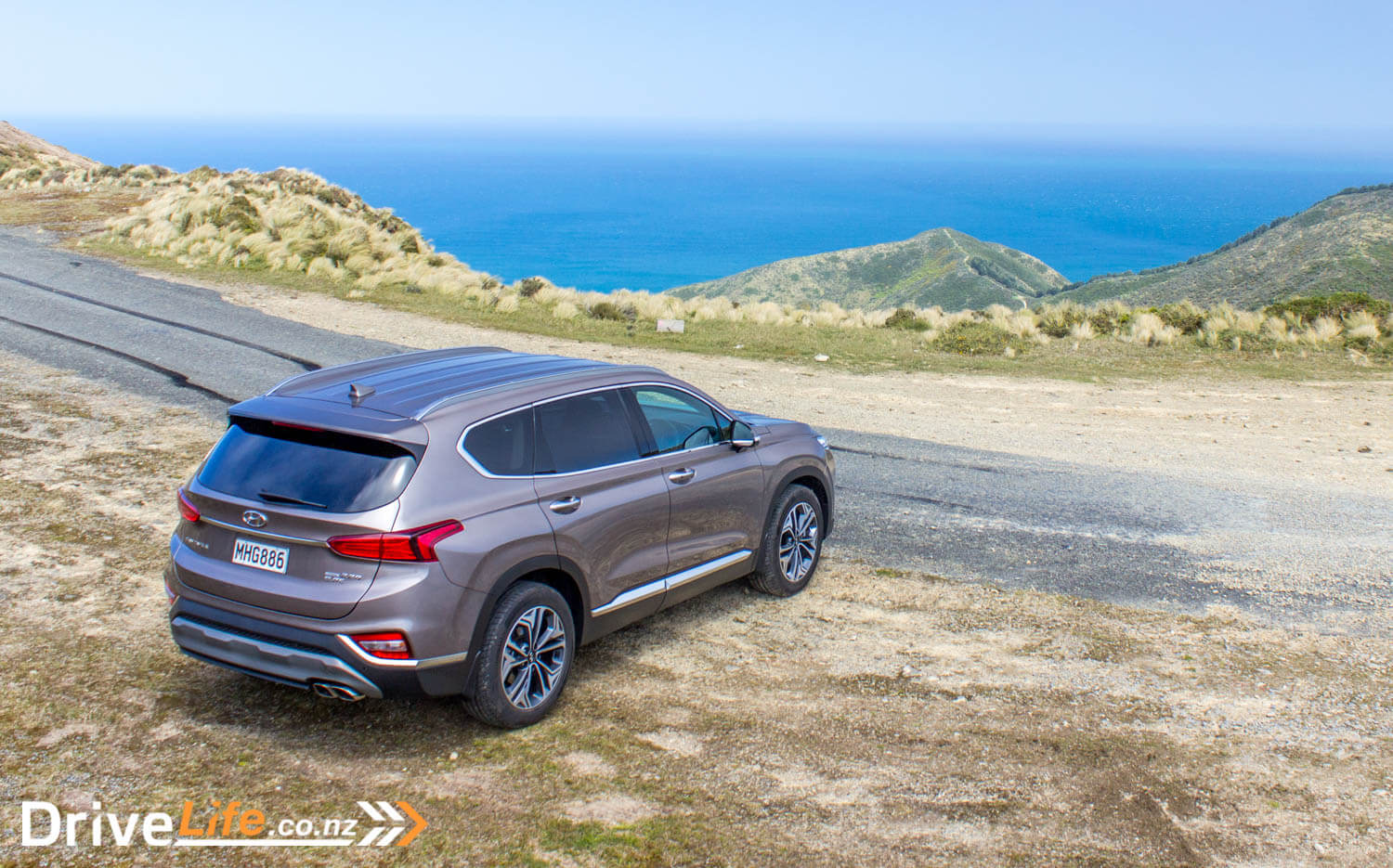
For some crazy reason, it’s taken over a year to get one for review, so we made the most of it, and added in a trip to Taupo and back to give the Santa Fe a hammering for a week.
It’s also Car Of The Year voting time, and the Santa Fe has made it into the top ten. Does it have what it takes to take the award out?
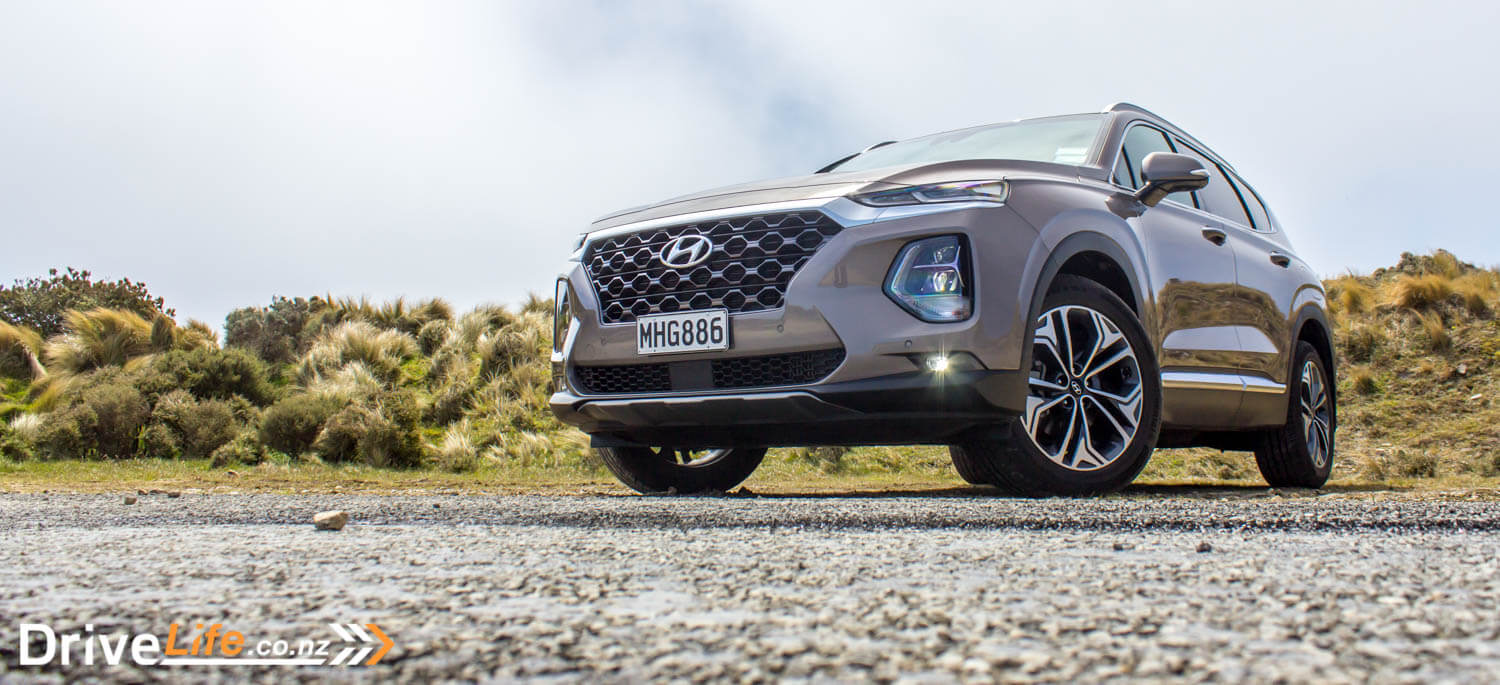
What’s In The 2019 Hyundai Santa Fe Range?
You get to choose from one of six models in the Santa Fe range; 3 models are petrol and 3 diesel. In each powertrain there’s three separate models; Entry, Elite, Limited.
All are 7 seats and all are AWD, so you need to take that into account when it comes to pricing.
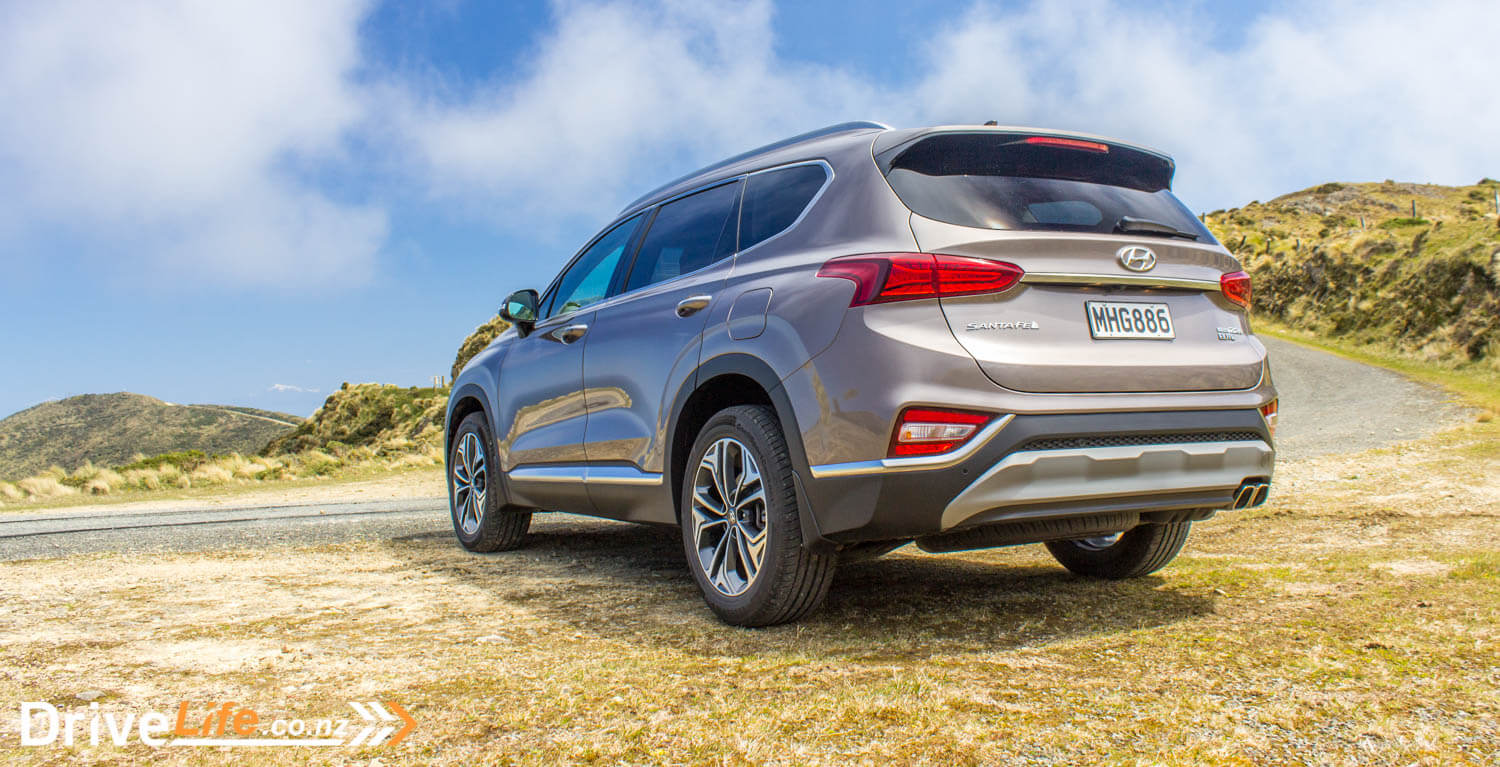
They are all relatively well kitted out, with the Entry model having a 4-speaker audio system with two additional tweeters, Dual-zone climate AC, third row AC, a 7” colour driver’s information display (DID), ‘Auto Link’ smartphone app so you can connect to your car, forward collision avoidance, rear cross-traffic alert, blind-spot collision warning, lane keep assist, lane departure warning, adaptive cruise control, driver attention alert, auto high beams, auto headlights, rear park assist, front park assist, a reversing camera, a first aid kit, electrically folding and heated side mirrors, LED DRLs, roof rails, a leather steering wheel and gear shift gaiter, split-folding second and third-row seats, keyless entry and start (proximity key), a 7” central touchscreen display, and also Android Auto and Apple CarPlay capability.
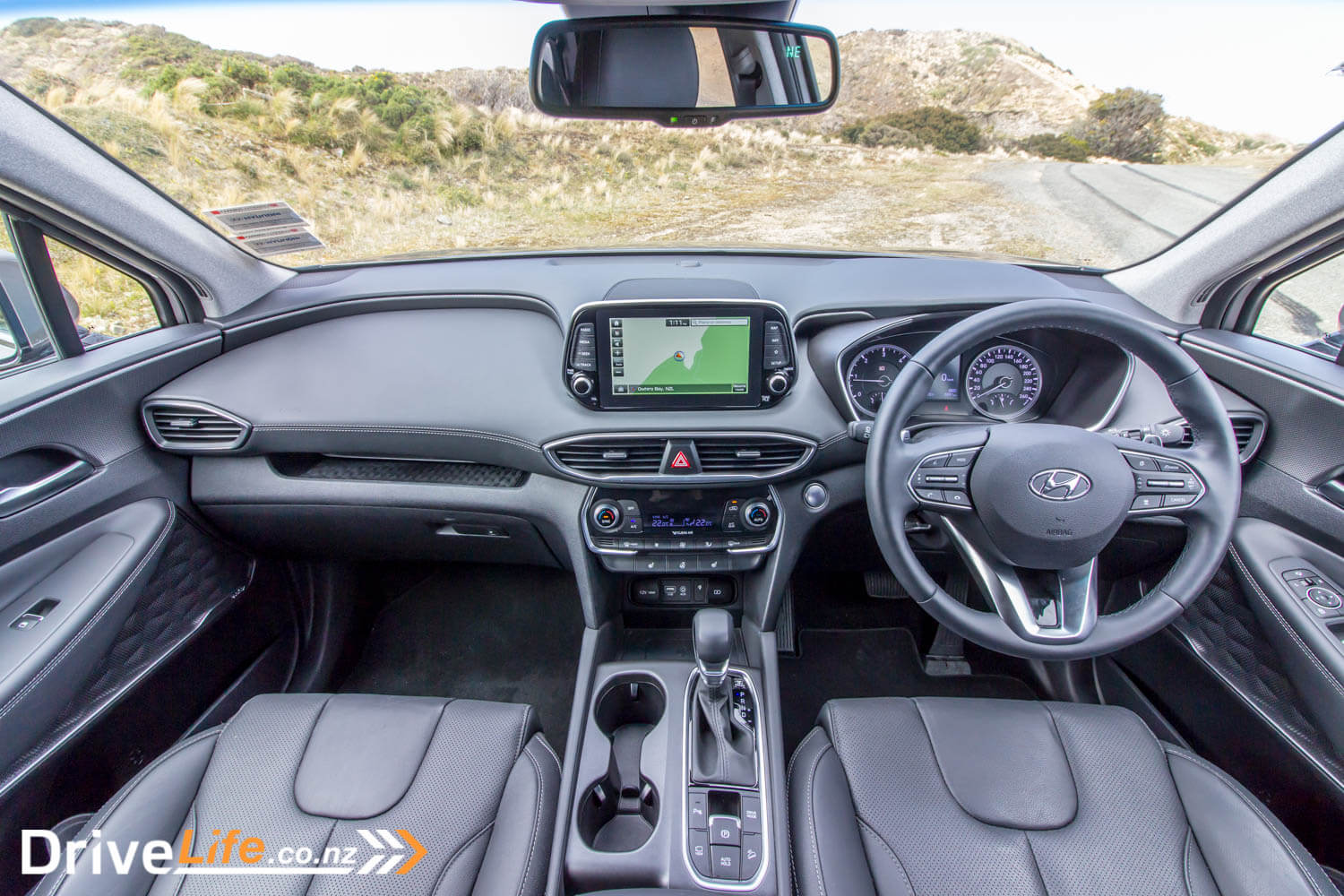
Moving your budget to the Elite model means you also get an Infinity 10-speaker audio system, a cooled glovebox, Rear Occupant Alert, auto wipers, LED headlights, LED taillights, privacy glass, solar glass, satin chrome exterior trim, a full leather interior, premium cloth pillar and headlining, a 10-way electric driver’s seat, an 8-way electric passenger seat, front and second-row heated seats, a heated steering wheel, Qi wireless phone charging, and an upgrade to an 8” central touchscreen display, with integrated SatNav.
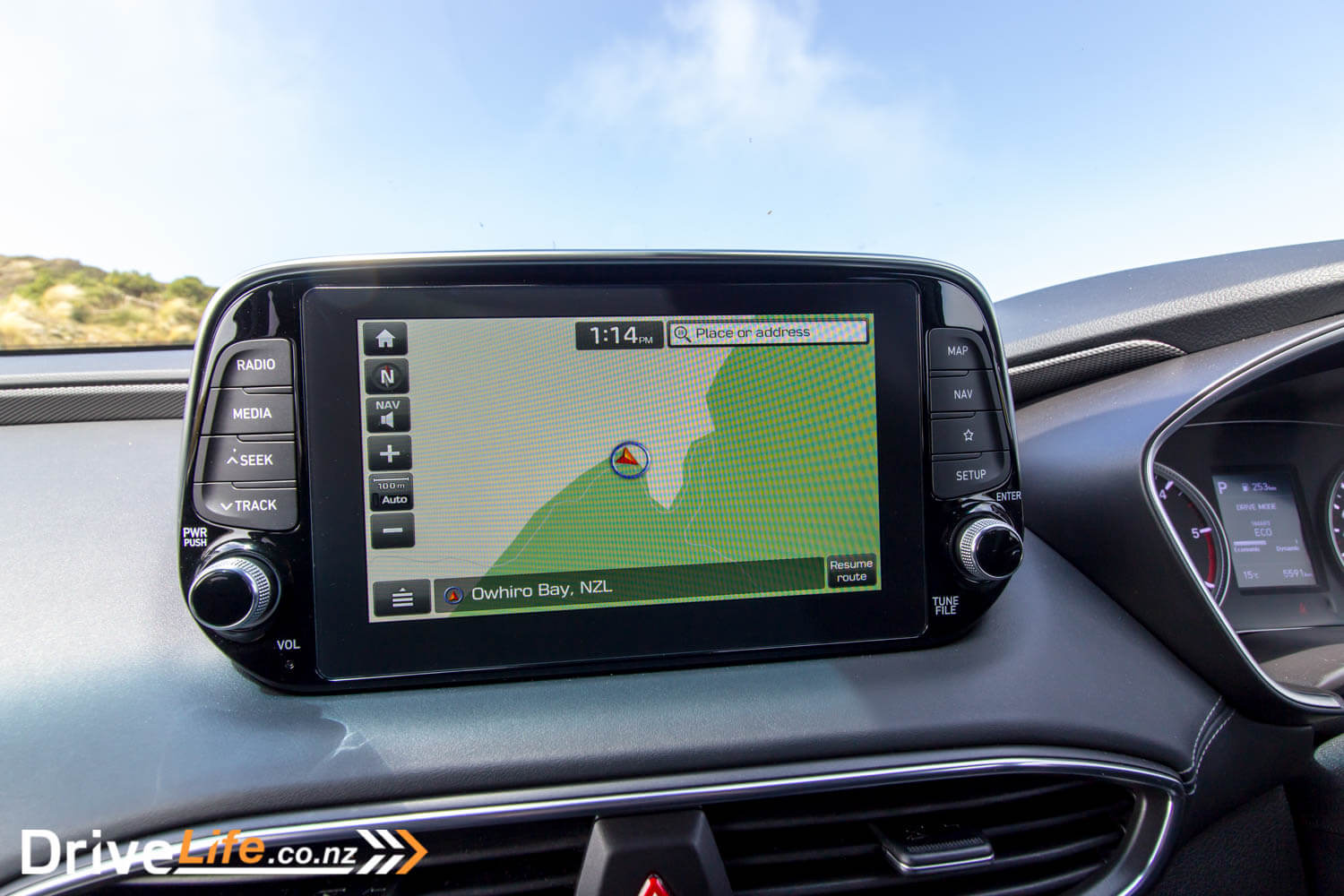
Top of the tree is the Limited model, which then adds a 7.0” colour DID, Auto Link Premium which includes remote vehicle monitoring, with geo-fencing and Guard/valet modes. There’s also automated parking (parallel or perpendicular), a 360-degree camera system, a panoramic sunroof, an electric tailgate, adaptive headlights, a laminated acoustic windscreen, a 14-way electric driver’s seat with memory function, ventilated front seats, a heads-up display, and LED interior lighting.
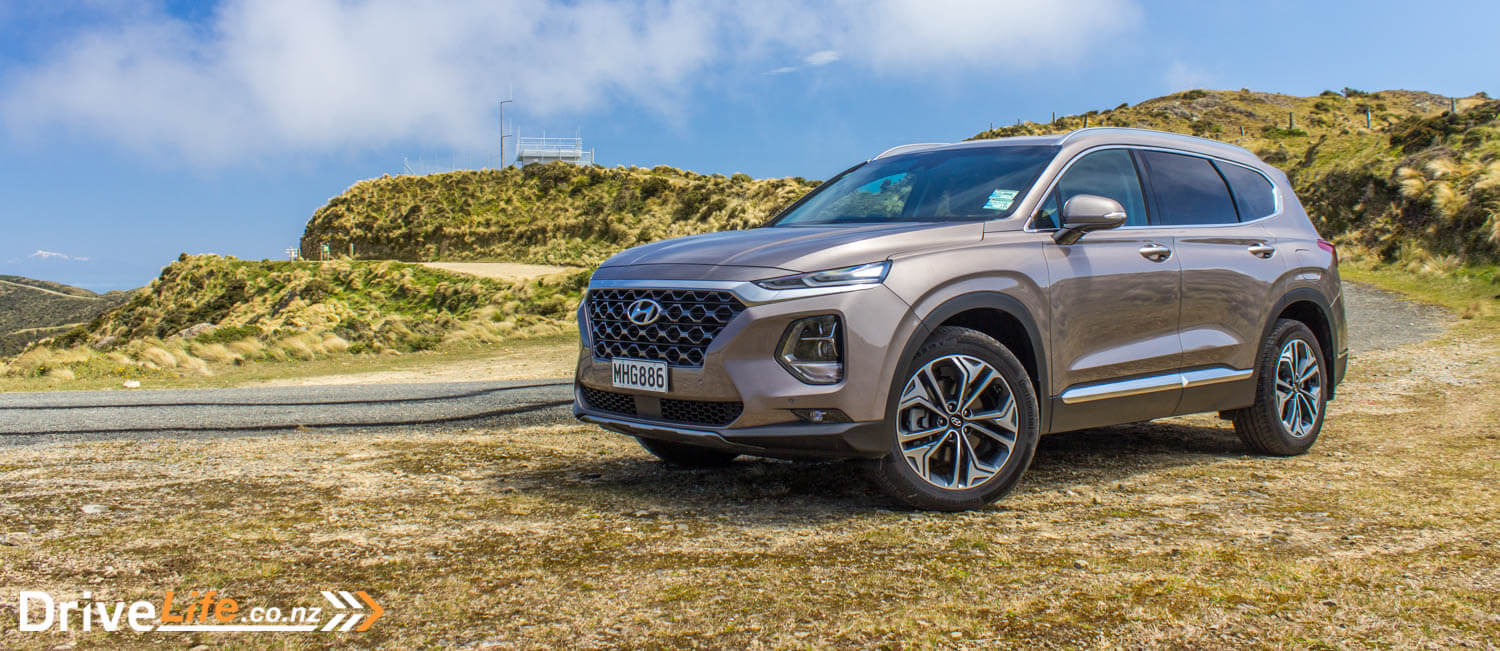
Mechanically, there’s a 2.4-litre petrol engine, which was carried over from the previous generation. This engine puts out 138kW of power, and 241Nm of torque. The diesel is a new 2.2-litre, four-cylinder that manages 147kW of power and a decent 440Nm of torque. Needless to say, Hyundai expects to sell a whole lot more diesels over petrol models. The petrol models run a 6-speed auto, while the diesel is an 8-speed.
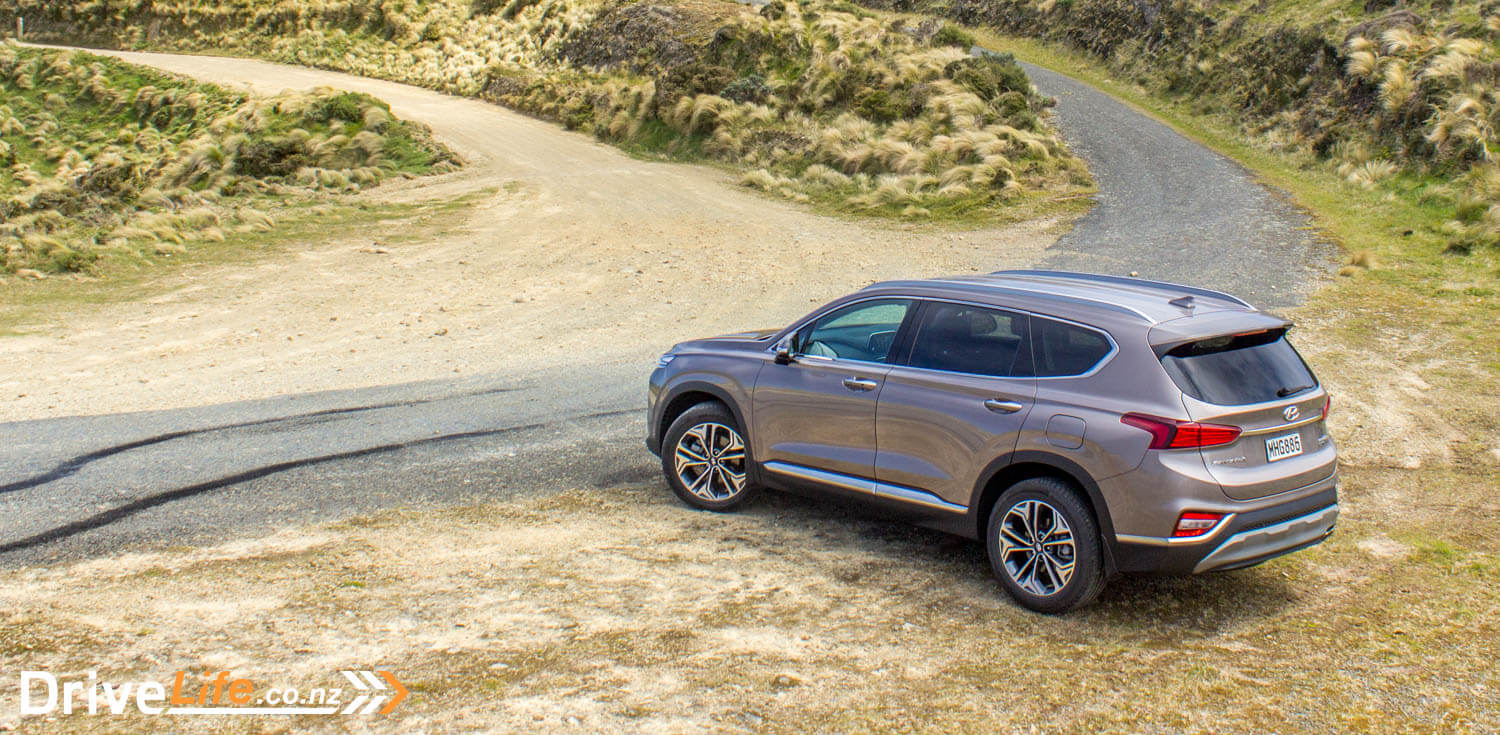
Pricing? It’s right up there. The base model petrol kicks off at $59,990. For an Elite petrol you’ll pay $69,490 and a petrol Limited is $75,490.
The diesels up the price some more, with a base model at $66,990, an Elite $76,990, and the top-gun Limited diesel is $82,990. So the result is very well equipped cars, with a price that reflects that.
You can read more about the Santa Fe on Hyundai New Zealand’s website.
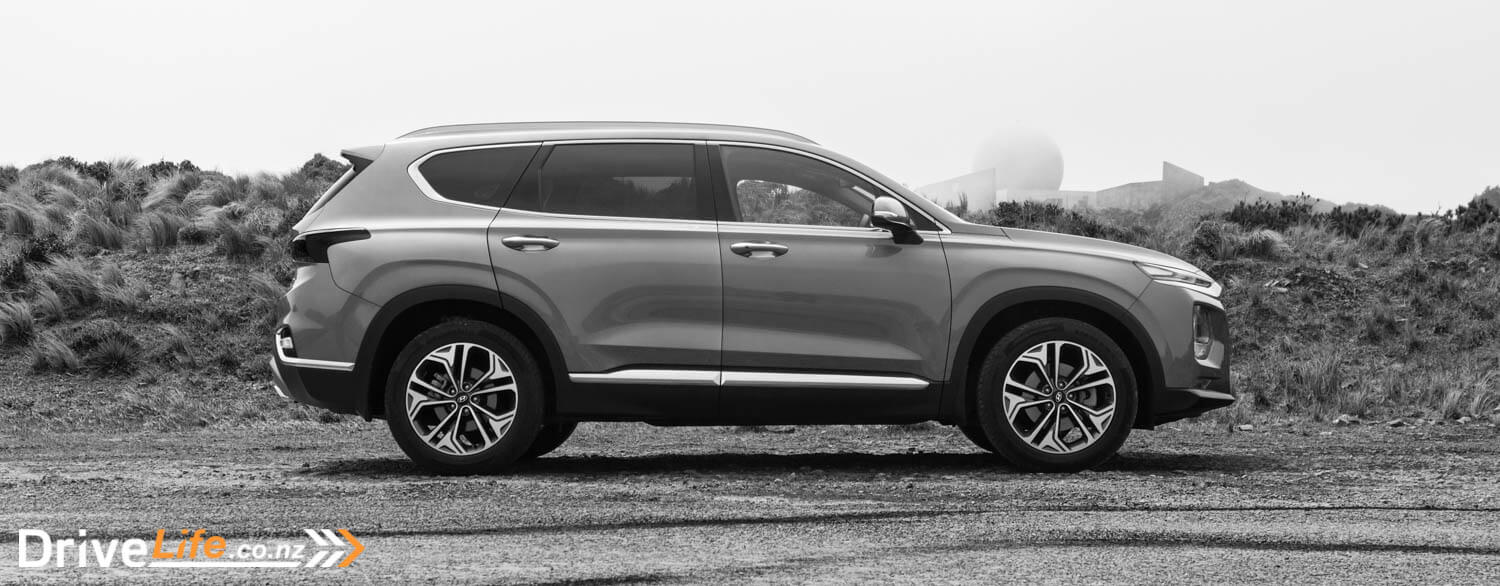
First Impressions Of The 2019 Hyundai Santa Fe Elite 2.2 diesel
There’s no mistaking it; this is a great-looking SUV. At any angle, the lines are spot on, with nice cohesion between all the design elements. I love the look of this car.
Up front, it’s pretty busy with lots of angles and shapes, but it all works. The scalloping on the sides of the car look excellent and make the car seem longer than it is, and the wheels on our Elite test car suited it perfectly. Hyundai have really nailed the entire design of this car.
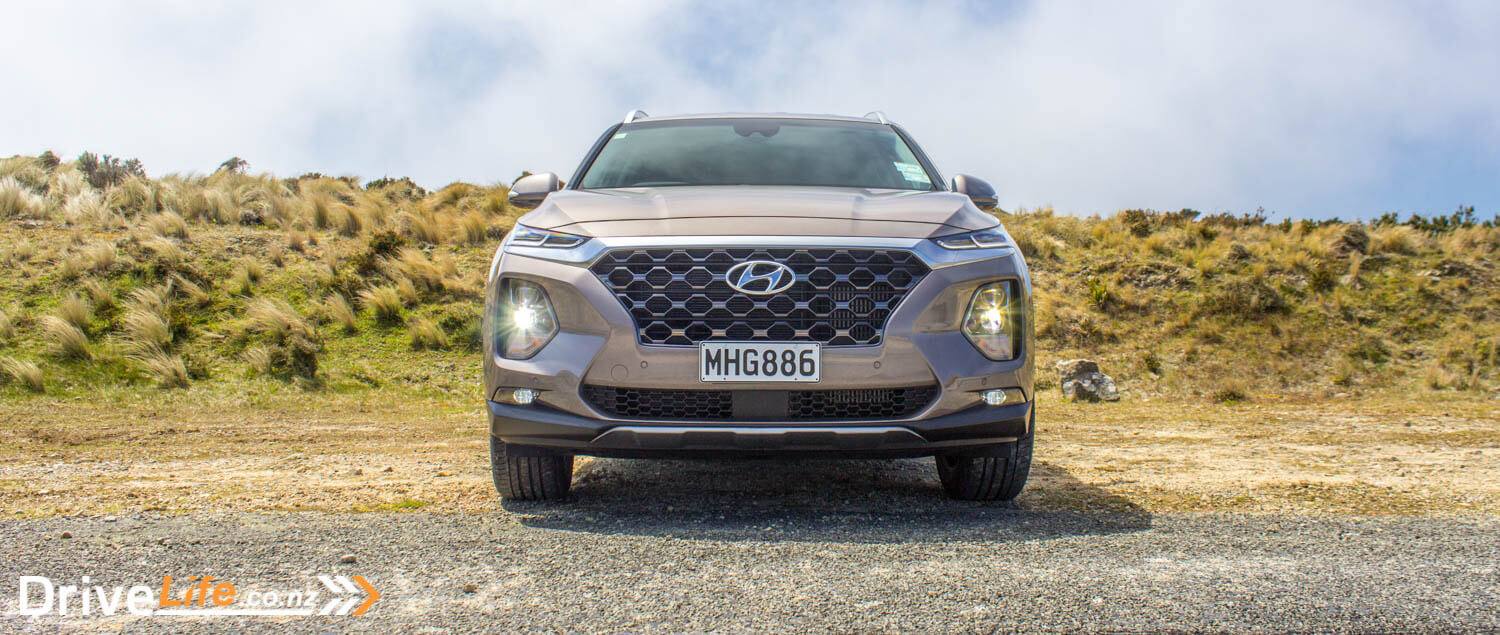
Our test car was finished in Earthy Bronze, which got mixed responses. I love any car that’s not silver or grey, so I was won over straight away. Many people considered it to be brown – even the label on the car’s key listed it as brown – but it’s more of a mix of champagne and bronze, in my eyes anyway.
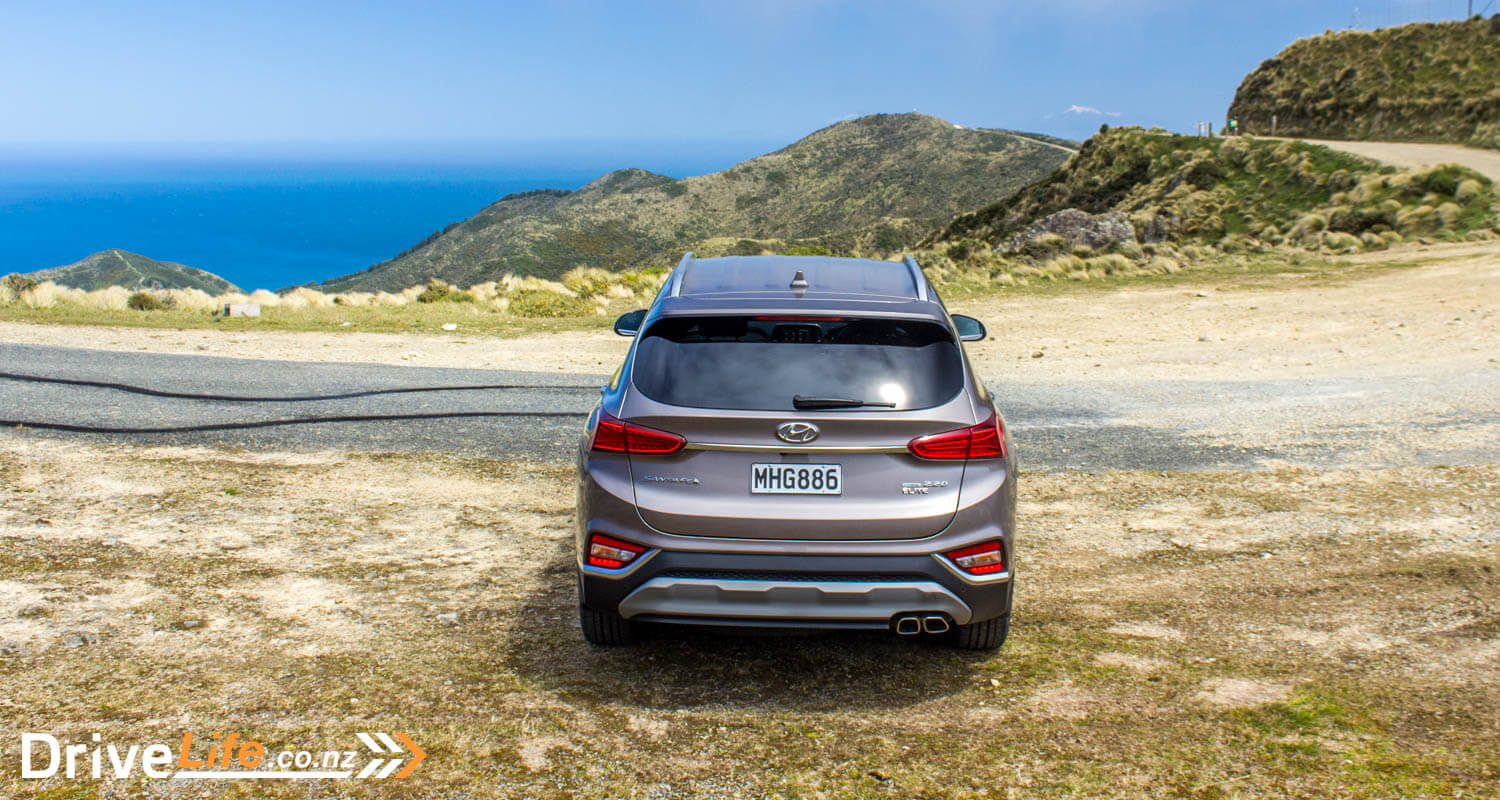
What’s The Inside Like On A 2019 Hyundai Santa Fe Elite 2.2 diesel?
The interior of the car was a real déjà vu moment from the launch, for me – the textures used inside the car are amazing. Hyundai have really gone all-out here to make sure there’s almost no flat, black plastic anywhere. Quality, classy, stylish – pick your adjective. That’s not to say a Mazda CX-8 doesn’t have an equally impressive interior, but I think the Santa Fe takes the prize away from most others.
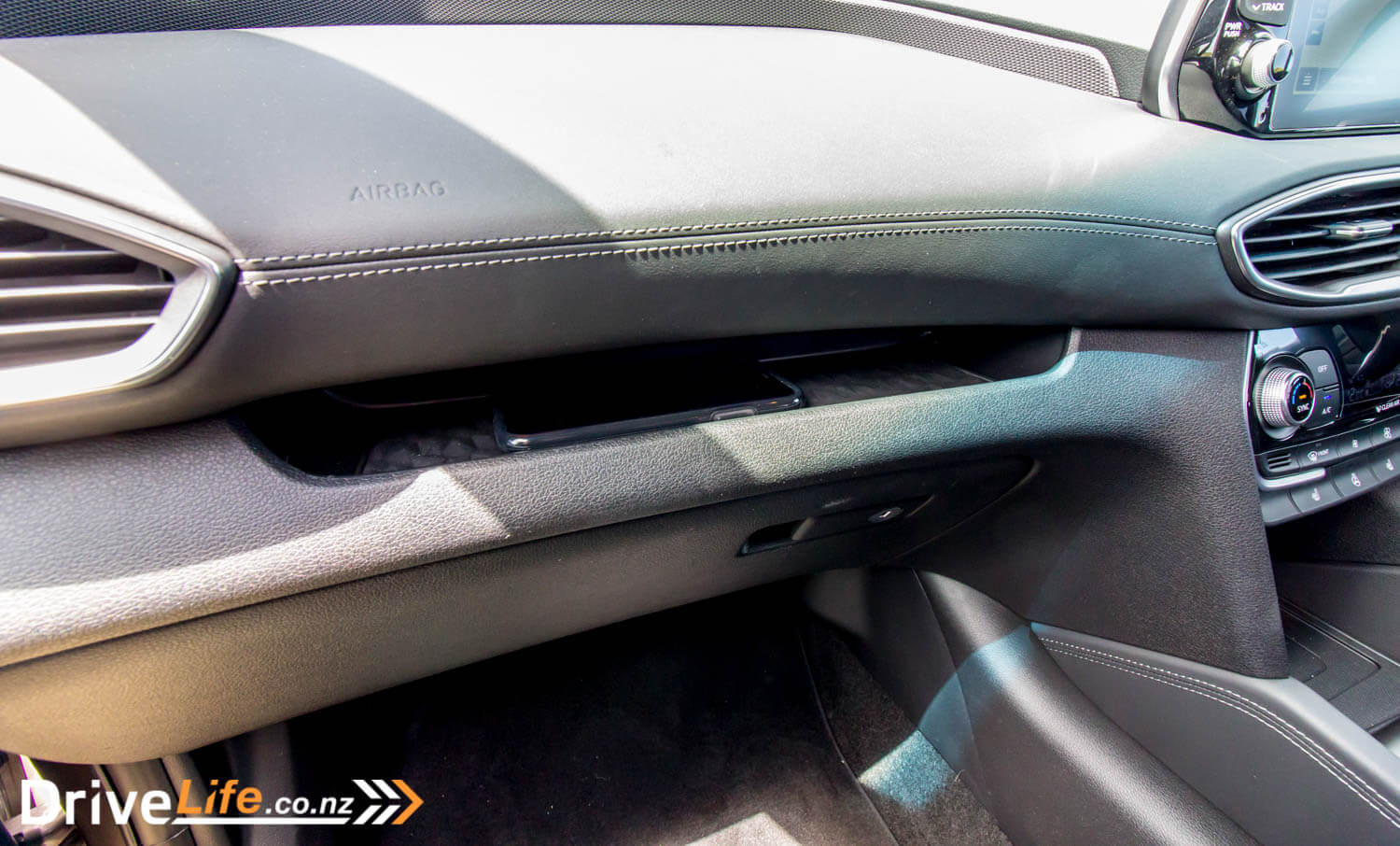
The doors have a diamond checked pattern, that is seen elsewhere in the cabin. In front of the passenger is a small shelf, which has the same diamond pattern on its base. It’s perfect for holding your cellphone, and you could probably fit 3 or 4 of them on there.
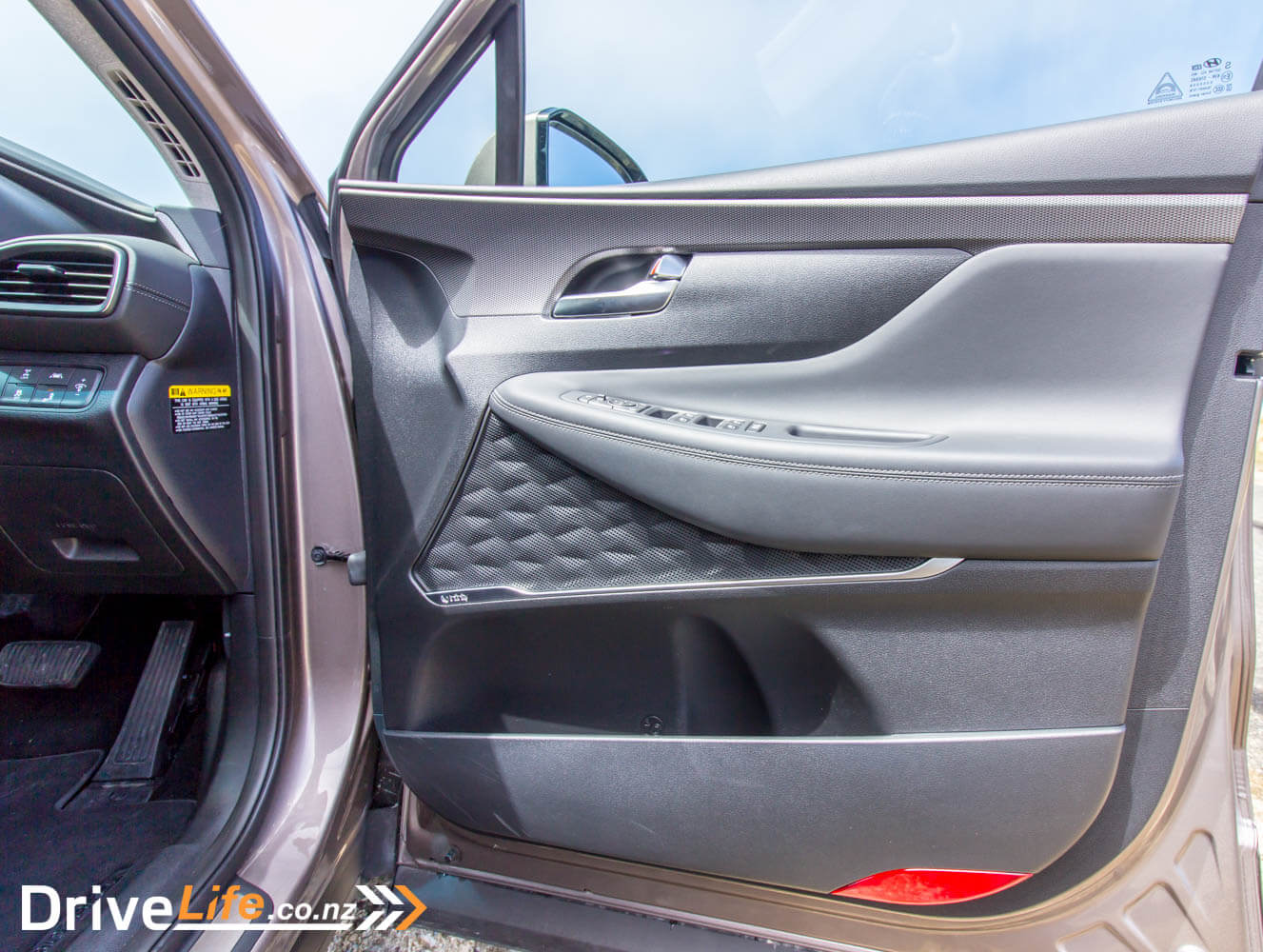
The interior of our test car was all black, but had a ‘knit’ grey headlining. This lifted the perceived quality of the car, and the grey colour also helped to keep it a bit lighter inside, since only the top-spec Limited model has a panoramic sunroof.
One thing that caught everyone’s eye were the two buttons on the top side of the front passenger’s seat. This adjust the backrest angle and fore/aft movement of the front passenger’s seat, and is intended to be used by either the driver or rear seat passengers, to move the passenger’s seat forward to give the rear passengers more room. That’s the theory, but I can honestly see a few bratty kids driving a parent crazy, making the seat go back and forth while they are sitting in it. Or maybe that’s just me. Funnily enough, I did use the buttons more than once myself, and found them quite handy.
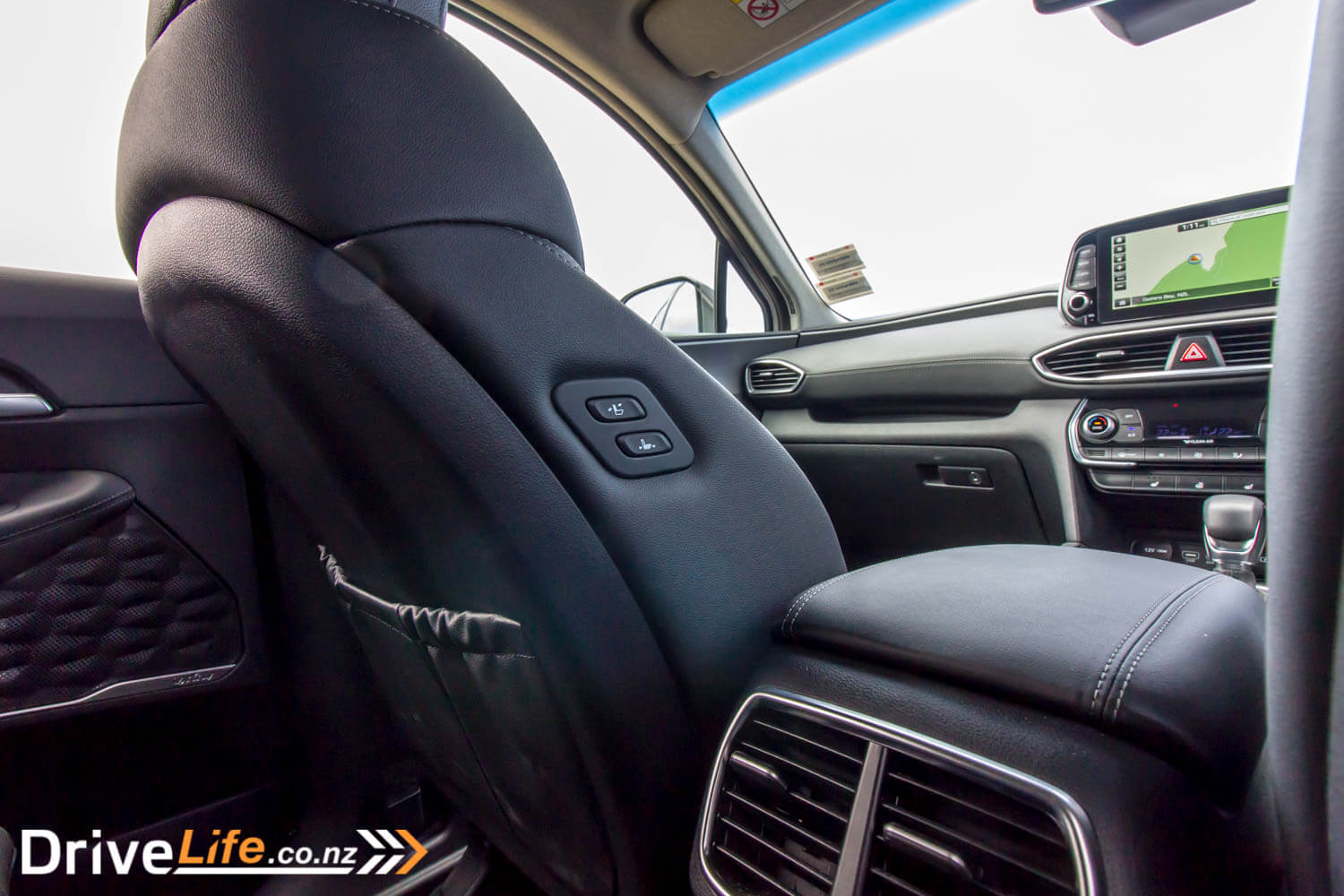
Rear seat passengers shouldn’t be complaining about rear legroom, as there’s plenty of it back there. Understandably, the third row is not as endowed with legroom, but the second row can slide forward if needed. Cargo room is good too, and up a little on the previous generation of the car.
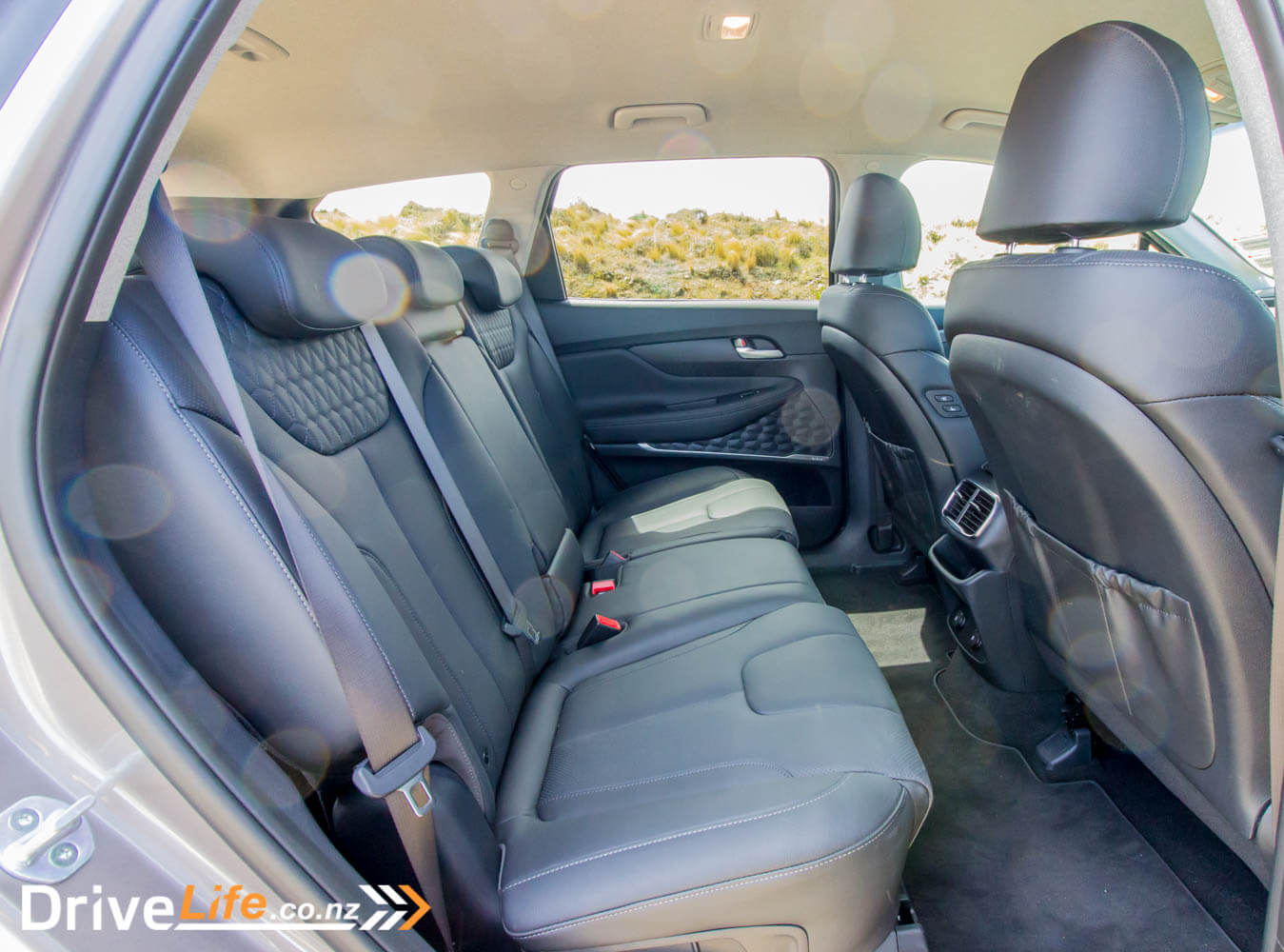
What’s It Like To Drive A 2019 Hyundai Santa Fe Elite 2.2 diesel?
Who doesn’t love a small, modern, turbo diesel motor? The 2.2-litre unit in the Santa Fe is bordering on excellent. It’s generally quiet, very smooth, but has that punch of torque you expect it to have. On the motorway, it’s almost inaudible, and it’s only around town and on the hills you’re reminded it’s a diesel. At idle it’s quiet too, and the smoothness overall is a stand-out.
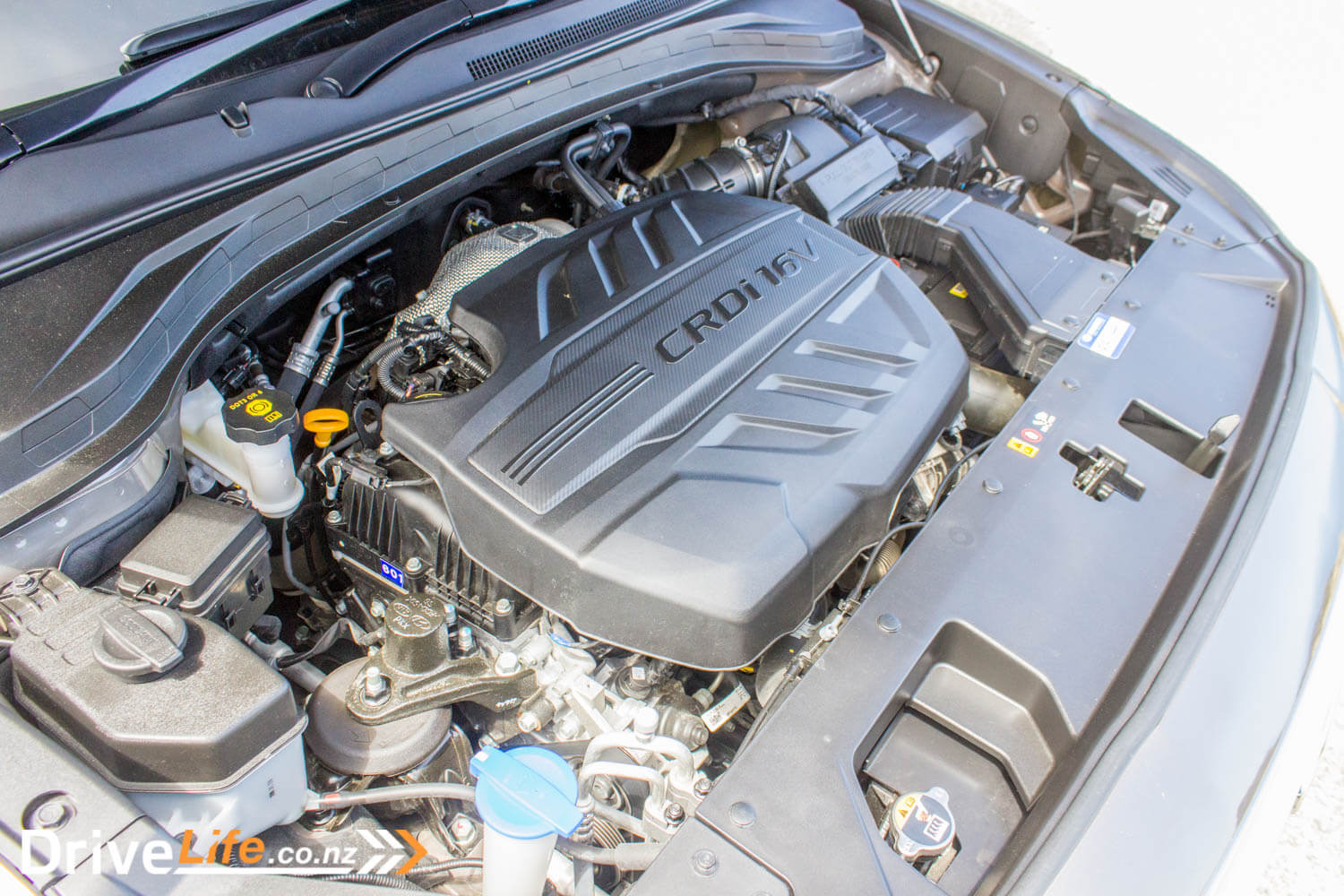
All models of Santa Fe are AWD, which is a nice touch. As usual, there are not too many options to play with the AWD system – a centre diff-lock button is welcome, as well as Hill Descent Control. The Driver’s Information Display can show you where the drive is going to at any time. This is also controlled by any of the drive modes, for example Eco mode will send 90% of the drive to the front wheels, while Sport mode sends 60% to the rear. I left the car in Smart mode, which allows it to choose what it’s going to do, and that’s fine with me. The Santa Fe should do well on the ski fields, or at the boat ramp.
The transmission is an all-new 8-speed unit, and it’s perfectly suited to the engine. Right gear, right time, every time. Smooth changes too, and it holds on to a gear nicely when going downhill.
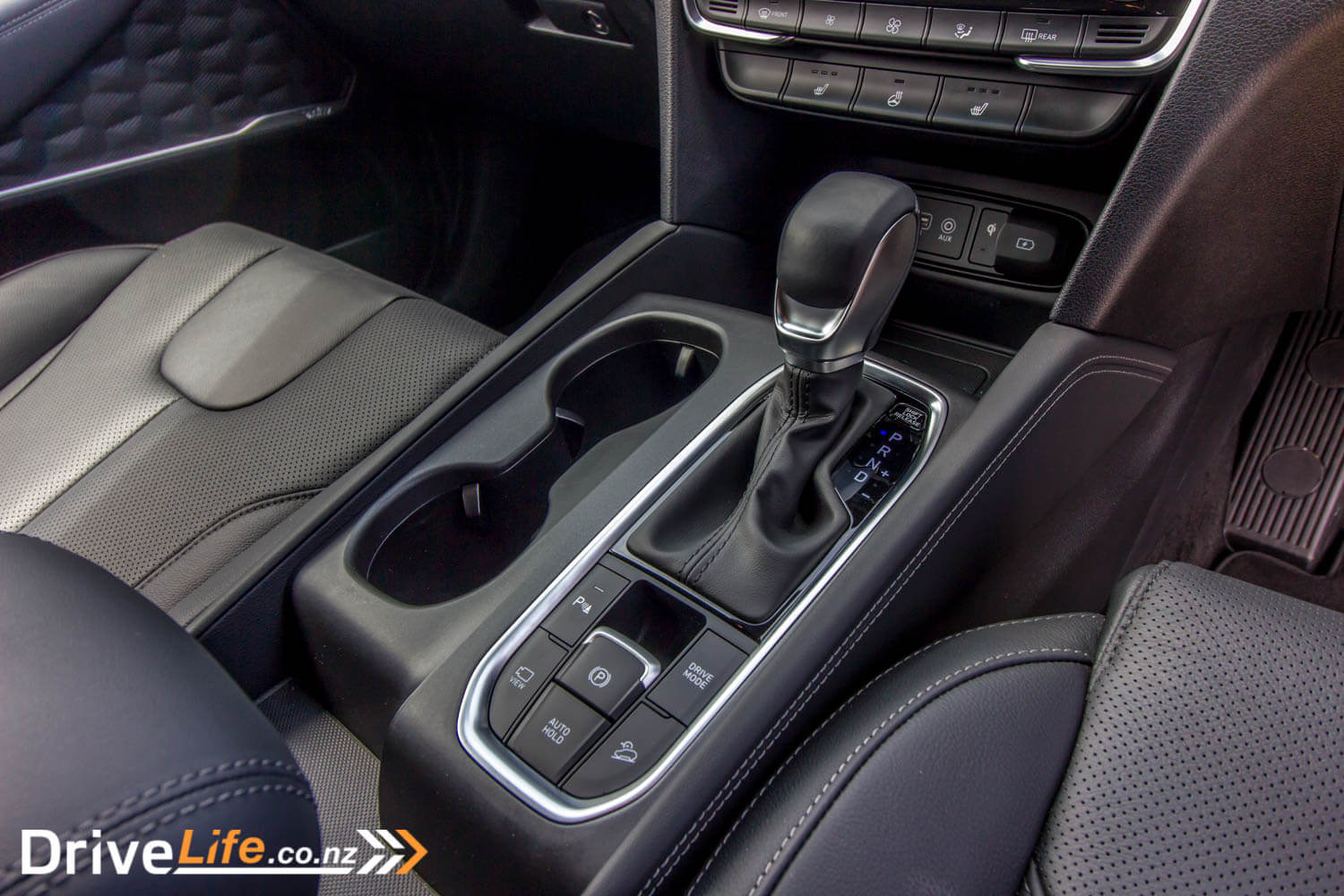
The drive to Taupo and back really showed what the car is capable of. Leaving at 5am, no traffic and simply set the adaptive cruise control – time to sit back and enjoy the drive. Silence is pretty golden in the Santa Fe, very little wind noise, almost no suspension noise, and the engine is barely a whisper on the open road.
It’s not all roses though. I went to put the town name only into the built-in SatNav, but no go – you have to enter a physical address. Not the end of the world though, and the SatNav does at least give you turn-by-turn directions in the driver’s information display (DID). A shame though, that the DID is black and white; I had expected full colour at this price, but you have to move to the top-spec model to get the active, colour display.
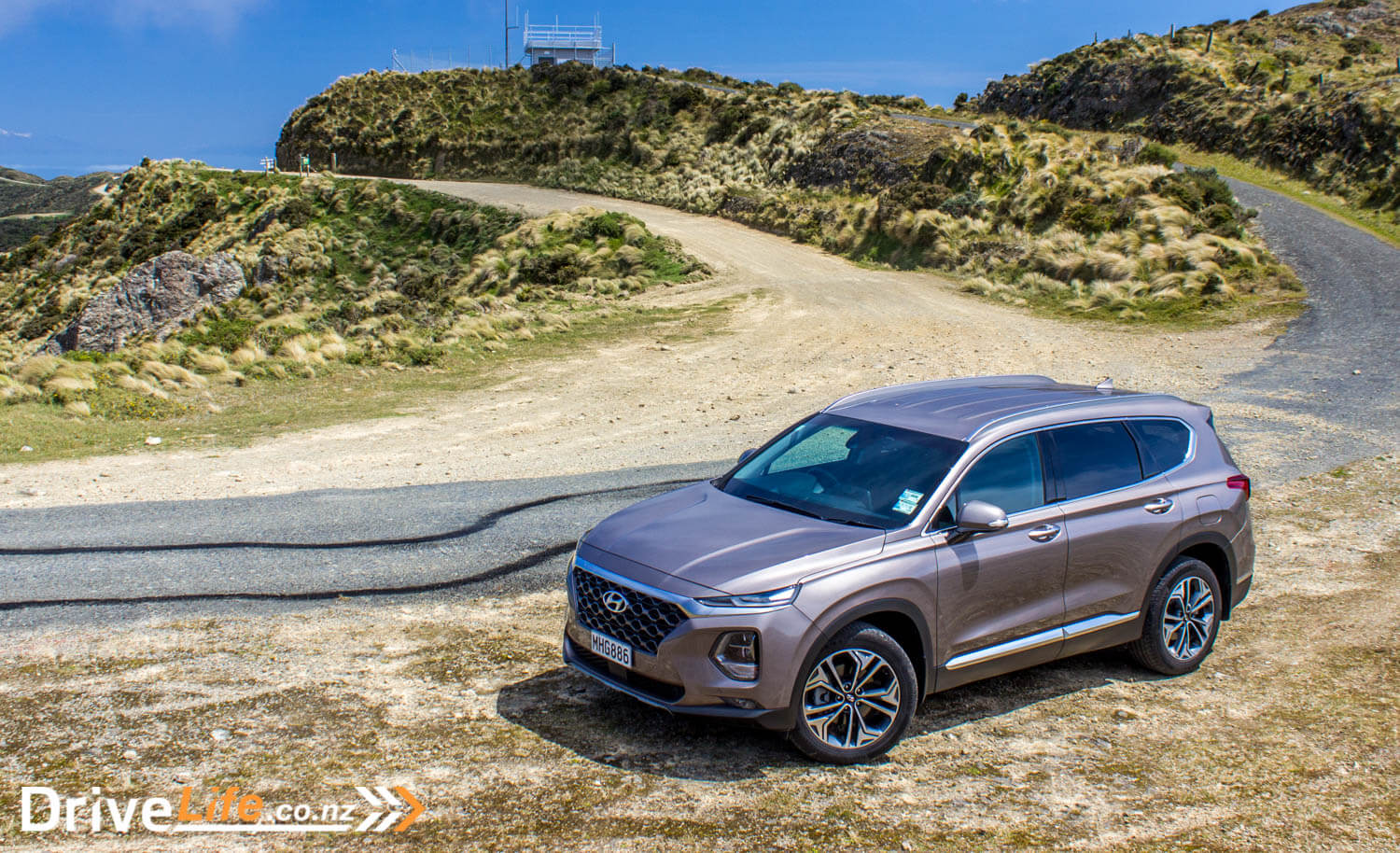
There’s a digital speedo thankfully, among all the other options you can show on the DID. I was a little disappointed that the digital speedo was so small – it only takes up a third of the available space on the DID. Since we are told only speeding is dangerous, it would have been much better to have it take up all the space in the display.
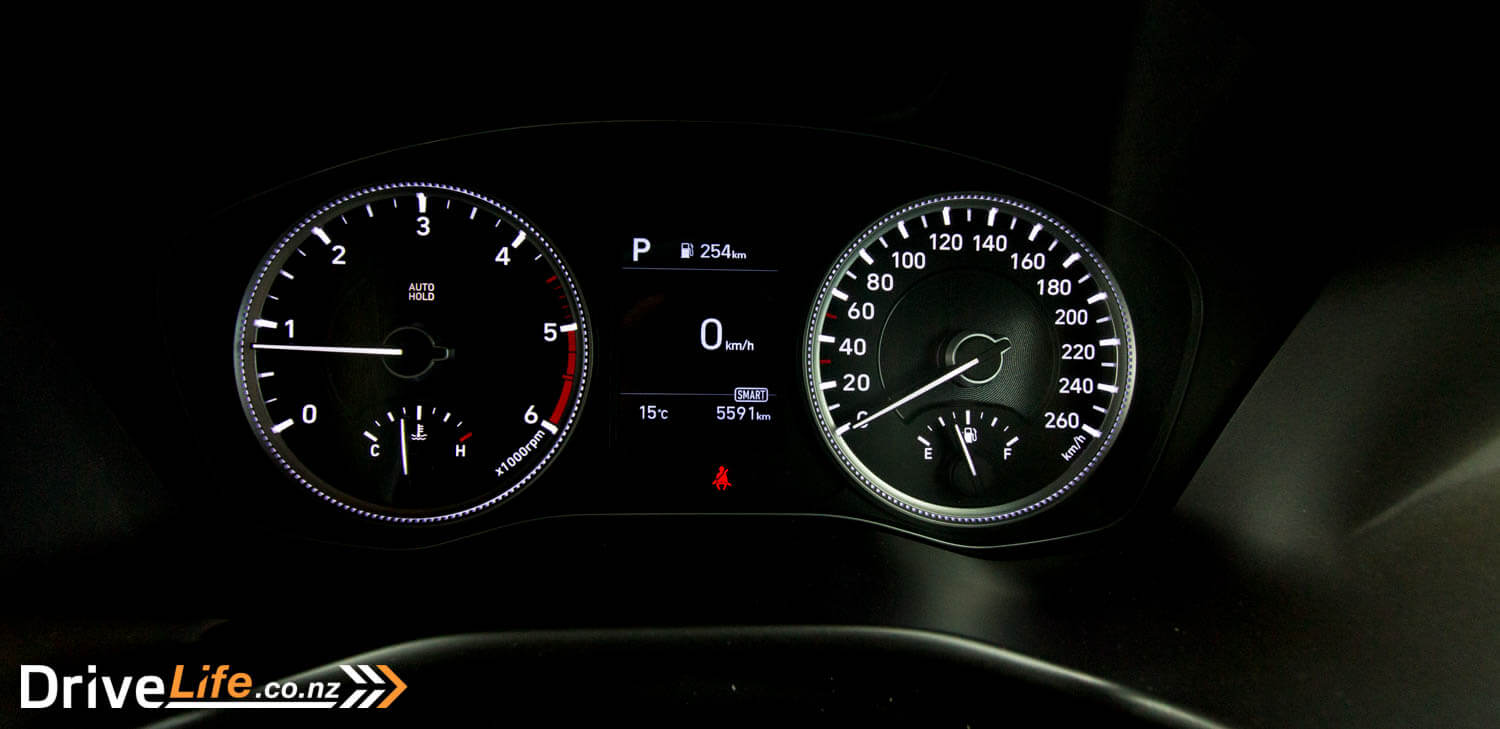
There are other niceties to help you on those long drives though, like the 2 USB ports up front, along with Qi wireless phone charging, an AUX port and a 12-volt socket. At near-on $76,000 I had expected all windows to be auto up/down, but only the driver’s window has this.
To make up for this, there are heated seats front and rear (first and second rows), and a heated steering wheel, which I always use.
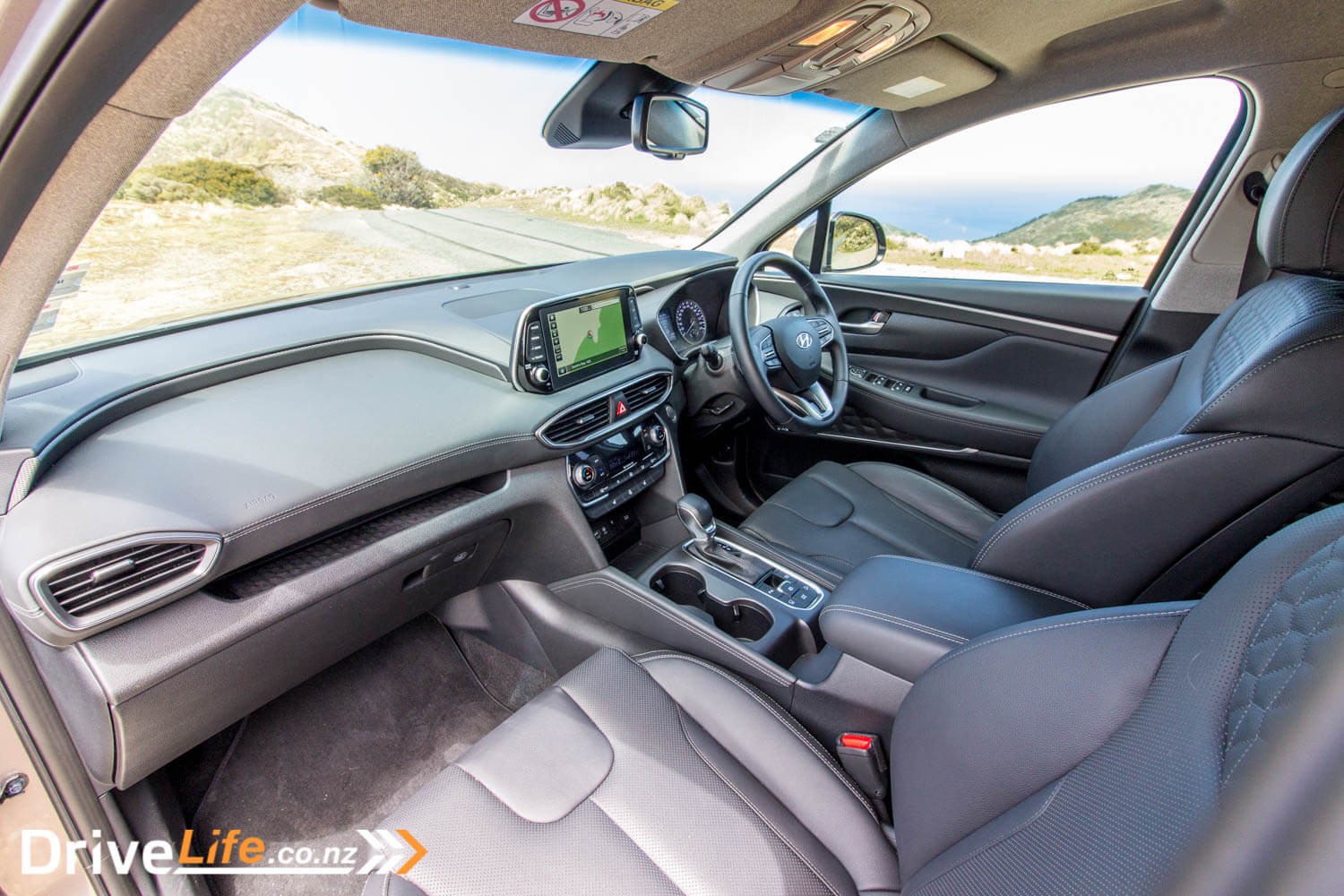
Other helpful long-trip amenities include a verbal warning of fixed speed cameras, and in addition to that you also get reminded verbally of what the current speed limit is. Nice touch. The steering wheel controls on the Santa Fe need a mention – they are near-on perfect. The tactile feel of them is excellent, and after only a few hours in the car, I barely needed to look down at them again. It was also nice – after moving from a Peugeot 508GT to the Santa Fe – that the audio controls are on the same side of the steering wheel. We’re seeing more and more cars that are splitting the audio volume/track controls to different sides of the wheel, and that makes my brain hurt.
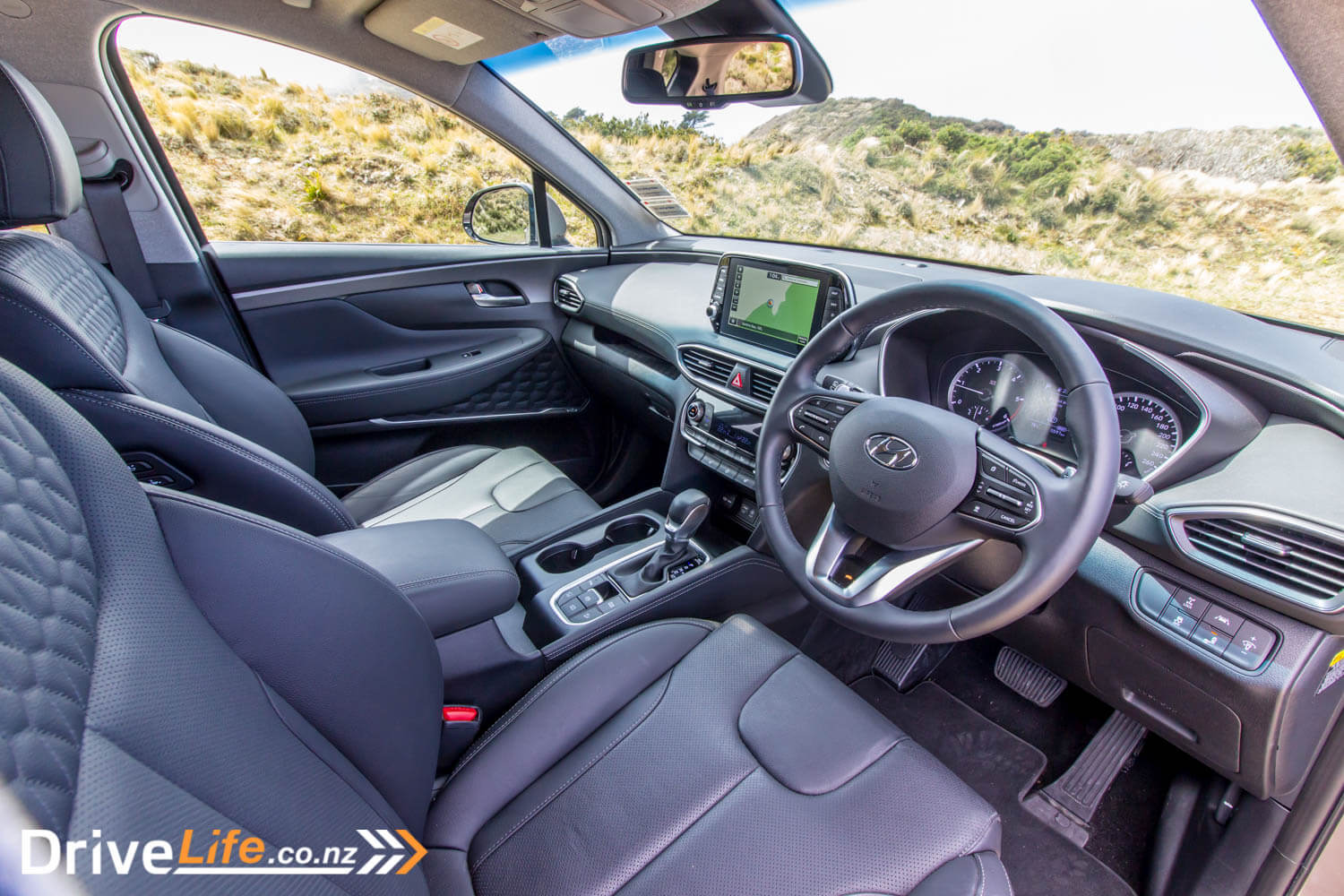
As mentioned, you get Qi wireless phone charging in the Elite model, and although it’s a flat base, it’s nicely rubberised and your phone doesn’t slide around, and then stop charging. Very much a set and forget scenario for this.
The hours rolled by on the way to Taupo, and seat comfort came into play. The fronts are electrically adjustable, including 4-way electric lumbar adjust. They’re also spot on for padding – not too hard, not too soft. I barely noticed the seats, so to me that means they must be good.
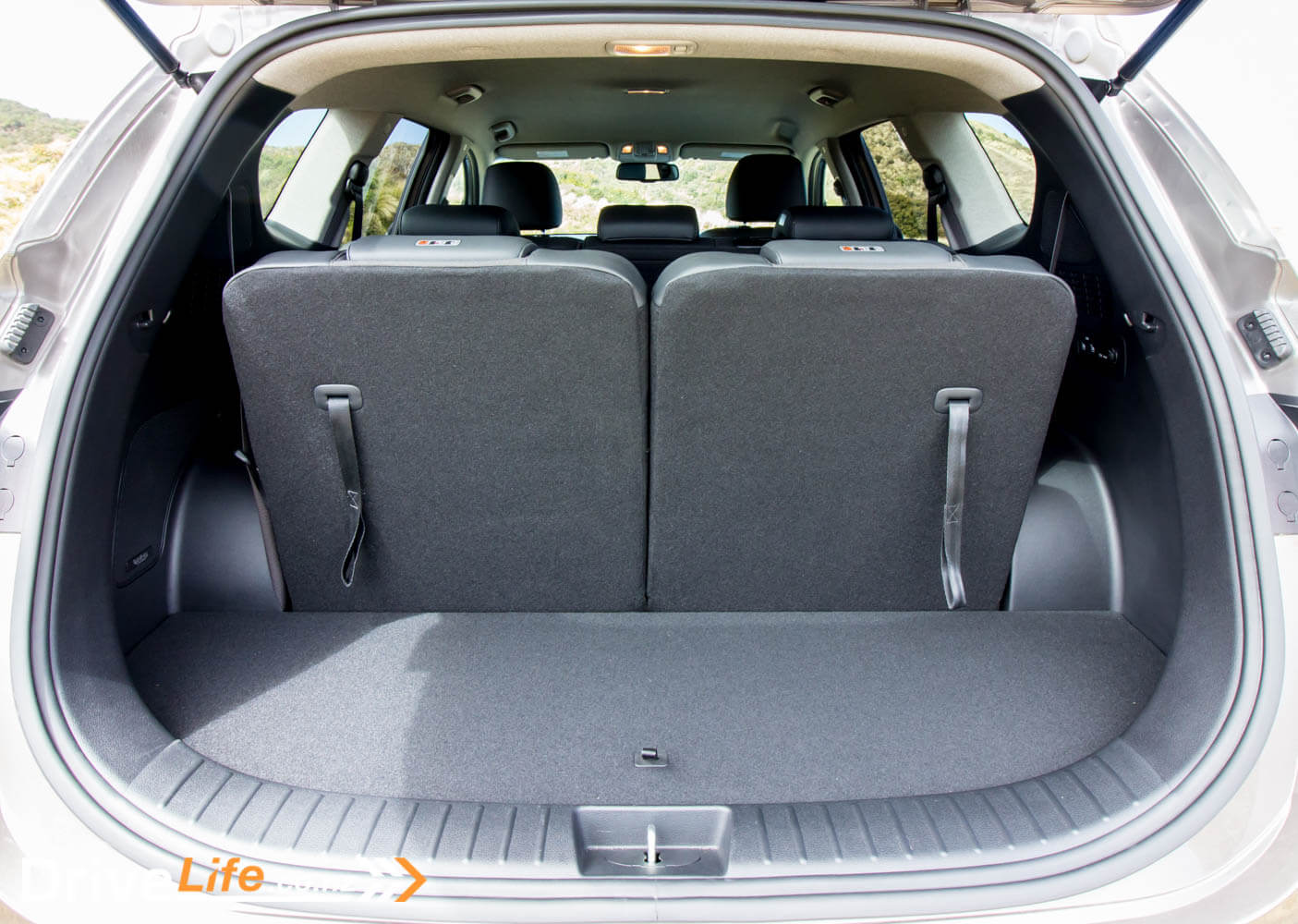
As the sun rose, I appreciated something that the Santa Fe has, that too many others don’t: sliding sun visors. I know it must be a money-saving thing, but having the visors so they slide to block out the sun better is a no-brainer. It’s simply safer. Unfortunately, it’s still a minority item.
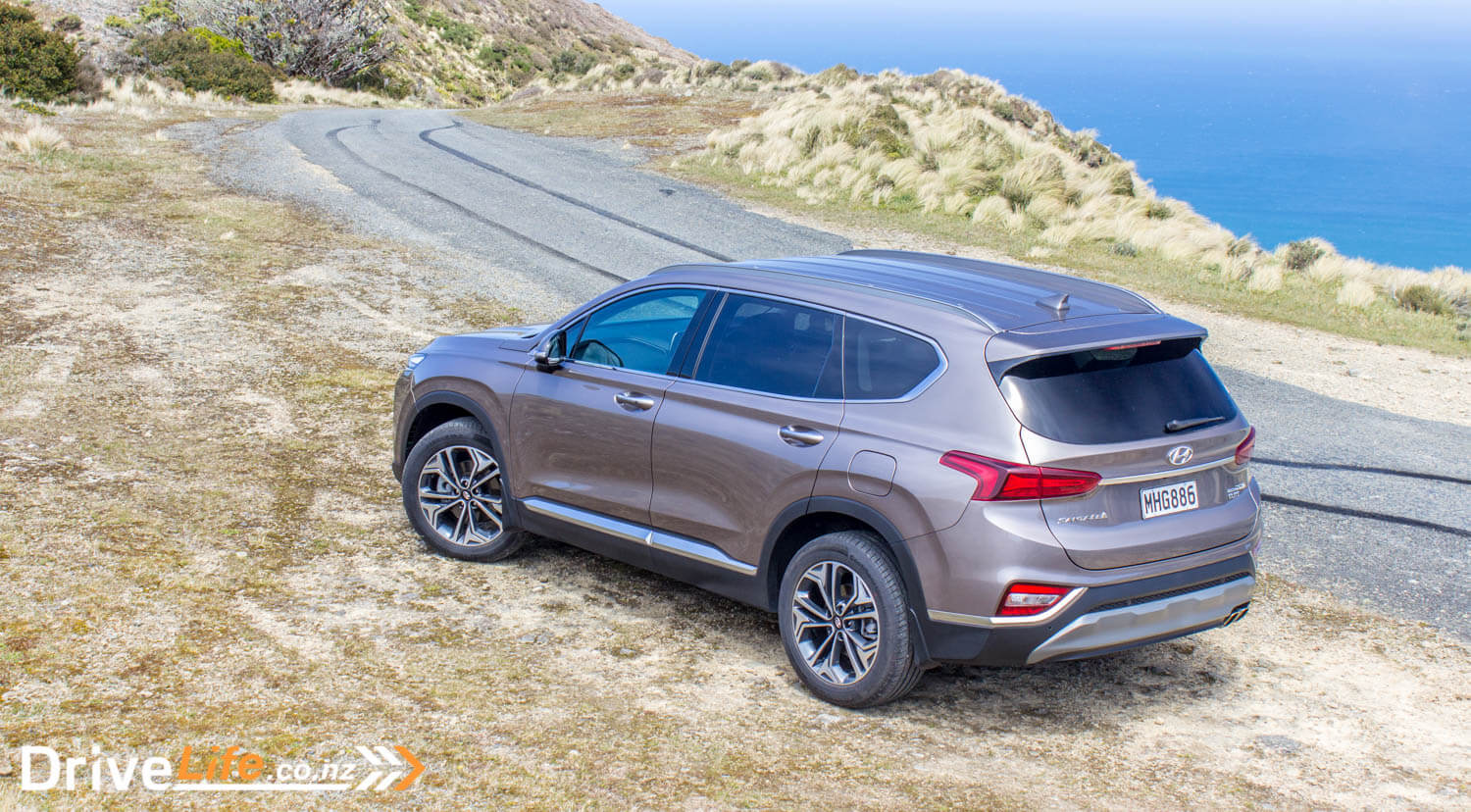
At last, we got to the Desert Road, with its windy bits. I love this road, and I love those tight corners, especially the ones that are decreasing radius, as they really test out a car’s handling. After driving the cars on the launch, I knew the Santa Fe would be pretty good around those bends. But it was better than good; grip is superb, with those Continental ContiSport tyres at 235/55/19. They feel great, and along with AWD you can start feeling pretty comfortable chucking the car about. The lack of traffic at this hour also meant I could push the car a fair bit, and it was bordering on fun. Complete control in the bends, not flat but still good, and with an excellent ride. The chassis on this car is brilliant.
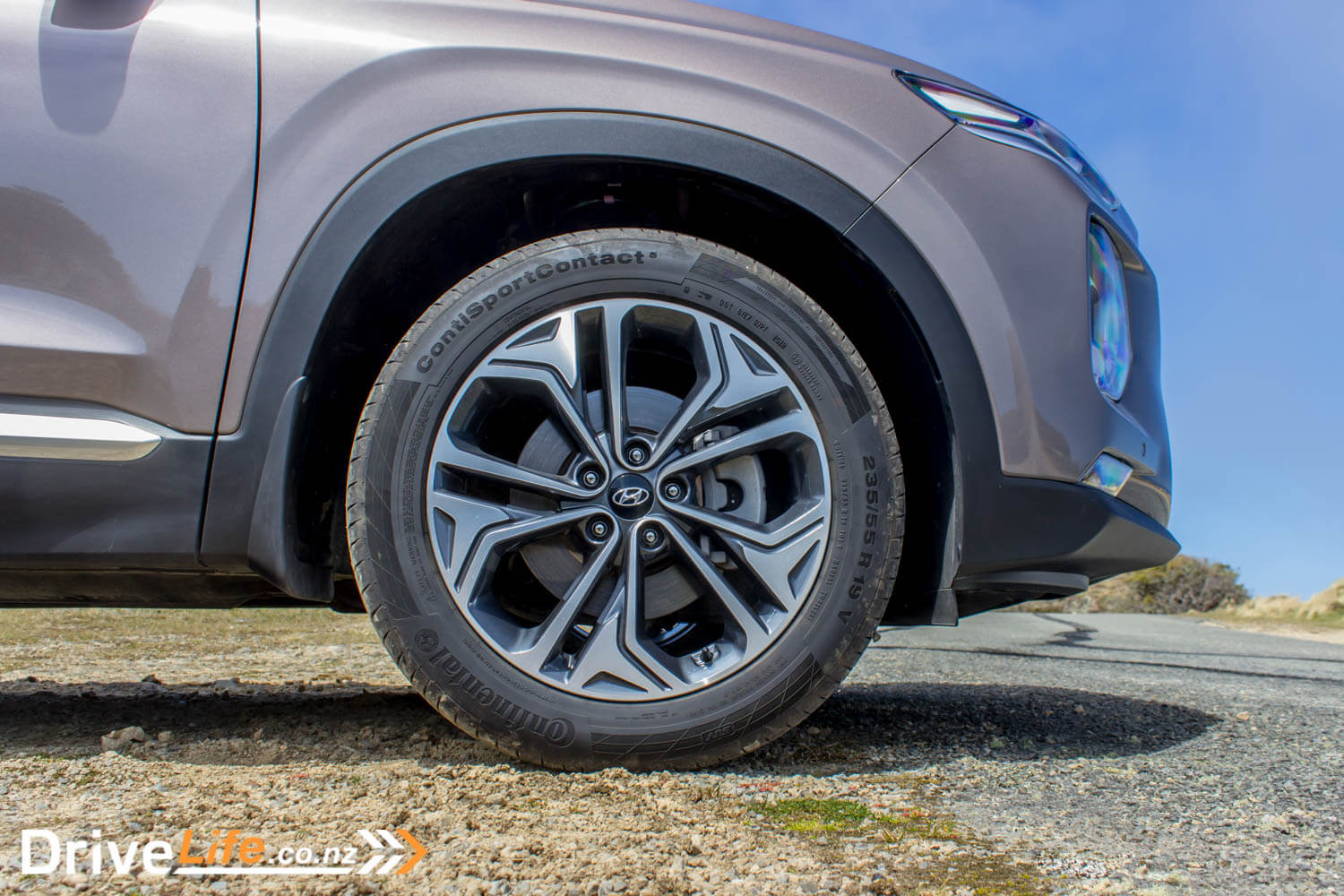
We stopped in Turangi to pick up another passenger, when I noticed it; we didn’t need to use the third row today, but I thought I’d take a look. A bit of a downer for the Santa Fe – while the second row is a 33/66 split, the 66% part of the seat is on the driver’s side. This isn’t as safe or as easy as having the larger part of the seat that flips forward, on the passenger’s (footpath side) of the car. The Holden Acadia is another car that comes to mind that has this same setup. But the Acadia is American, so you can understand why this is. I don’t know why this is the case in the Santa Fe.
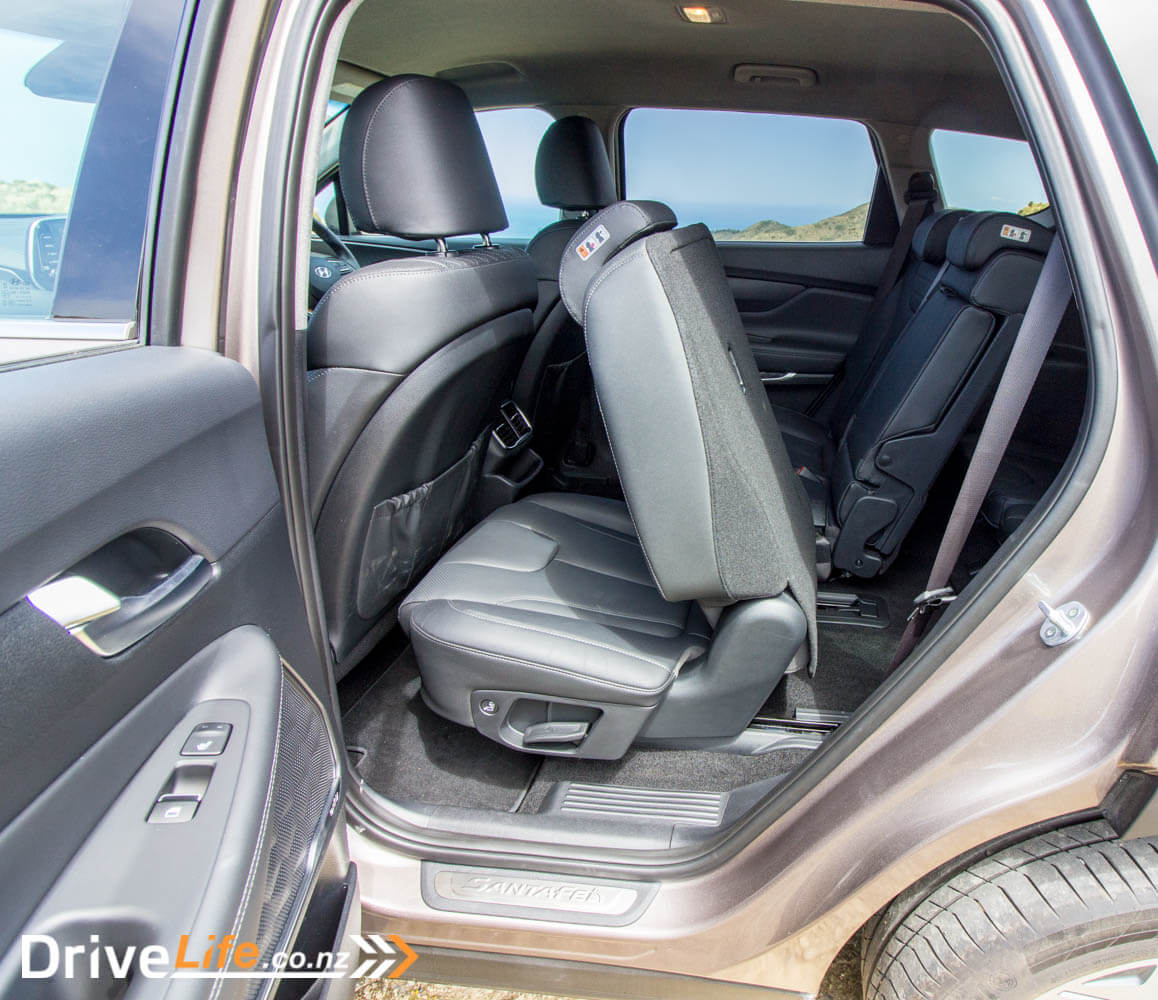
I’ve mentioned that second-row passengers get two USB ports, which is great. In the third row, there’s no USB but there is a 12-volt power socket. There’s also roof-mounted and side air-con vents for the third row, and they have their own controller for this back there as well. Nice one, Hyundai. Second-row passengers get two console-mounted vents for AC, controlled from the front of the car.
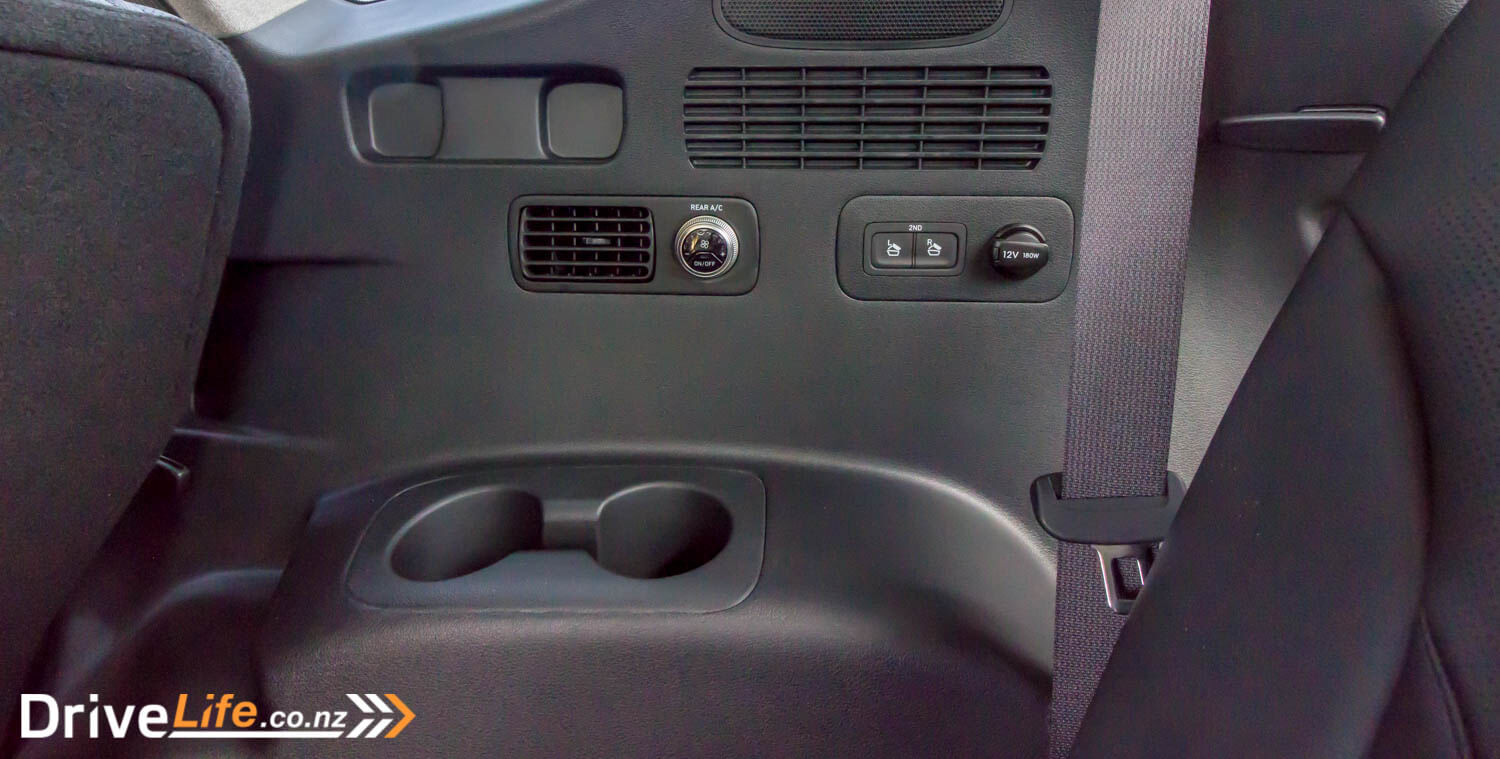
From Turangi, we got a few opportunities to do some overtaking manoeuvres, now we had more traffic about. While the Santa Fe is great off the mark, it does lose some power at the top end. Still, the delivery is good, and we didn’t get into any trouble. It can really move it, for such a large, heavy SUV with a smallish 2.2-litre engine.
We’ve said it so many times before: when you go to a launch and love a car, it doesn’t mean you will love it after spending a decent amount of time behind the wheel. This was the case with the Santa Fe as well. One of those things was the Lane Keep Assist (LKA) – it’s too aggressive. I felt like I was fighting the wheel far too often, and that got tiring. So I turned it off. But then, when you get out of the car and back in again, it turns itself back on.
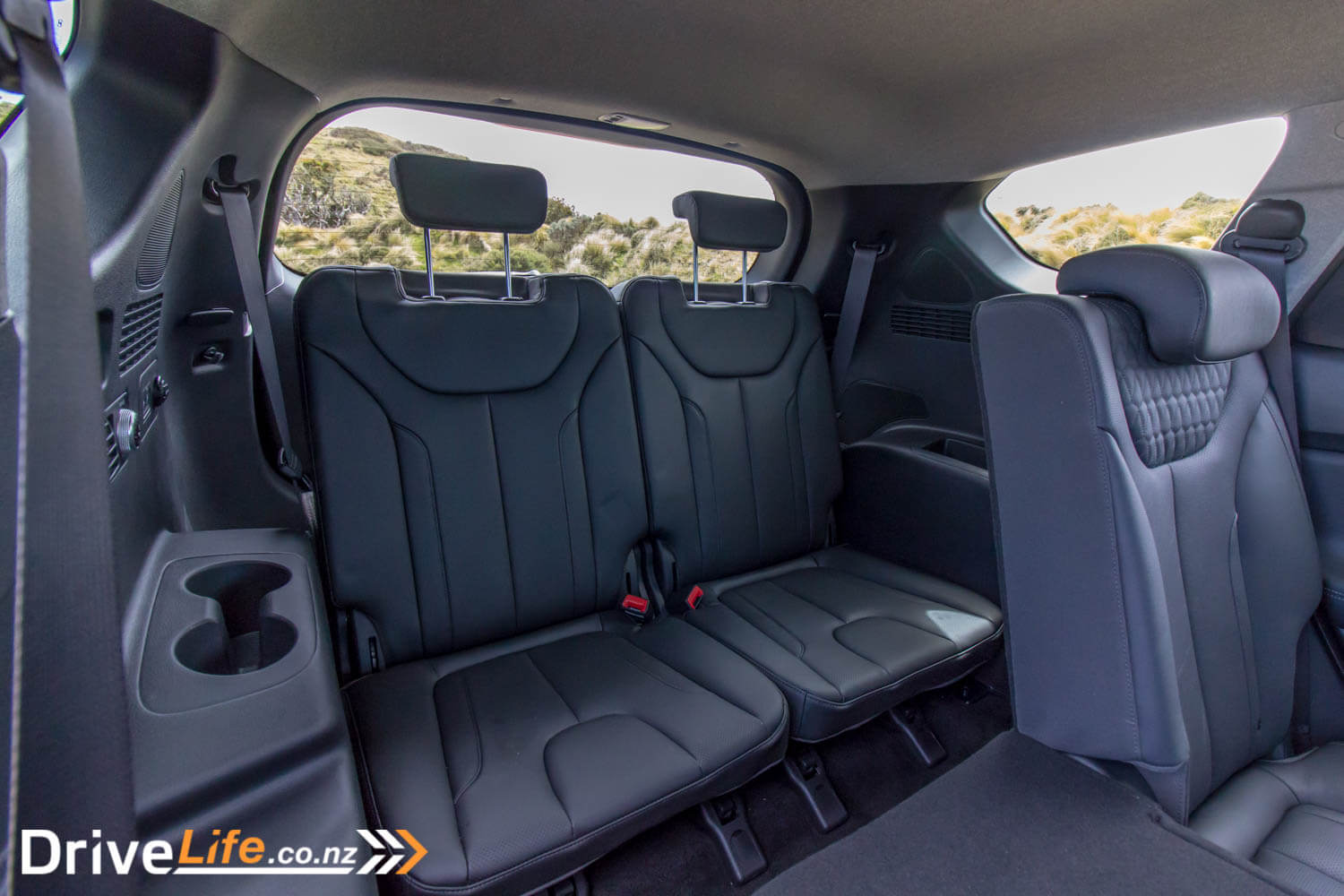
Second slightly annoying thing; I love the auto-hold feature for the park brake. Sit at the lights with your foot ready to go on the gas, since the car has auto-hold working. But it’s the same deal as LKA – it turns itself off when you get out of the car. I’d at least like the option to do this (or not) from the menu settings in the infotainment system.
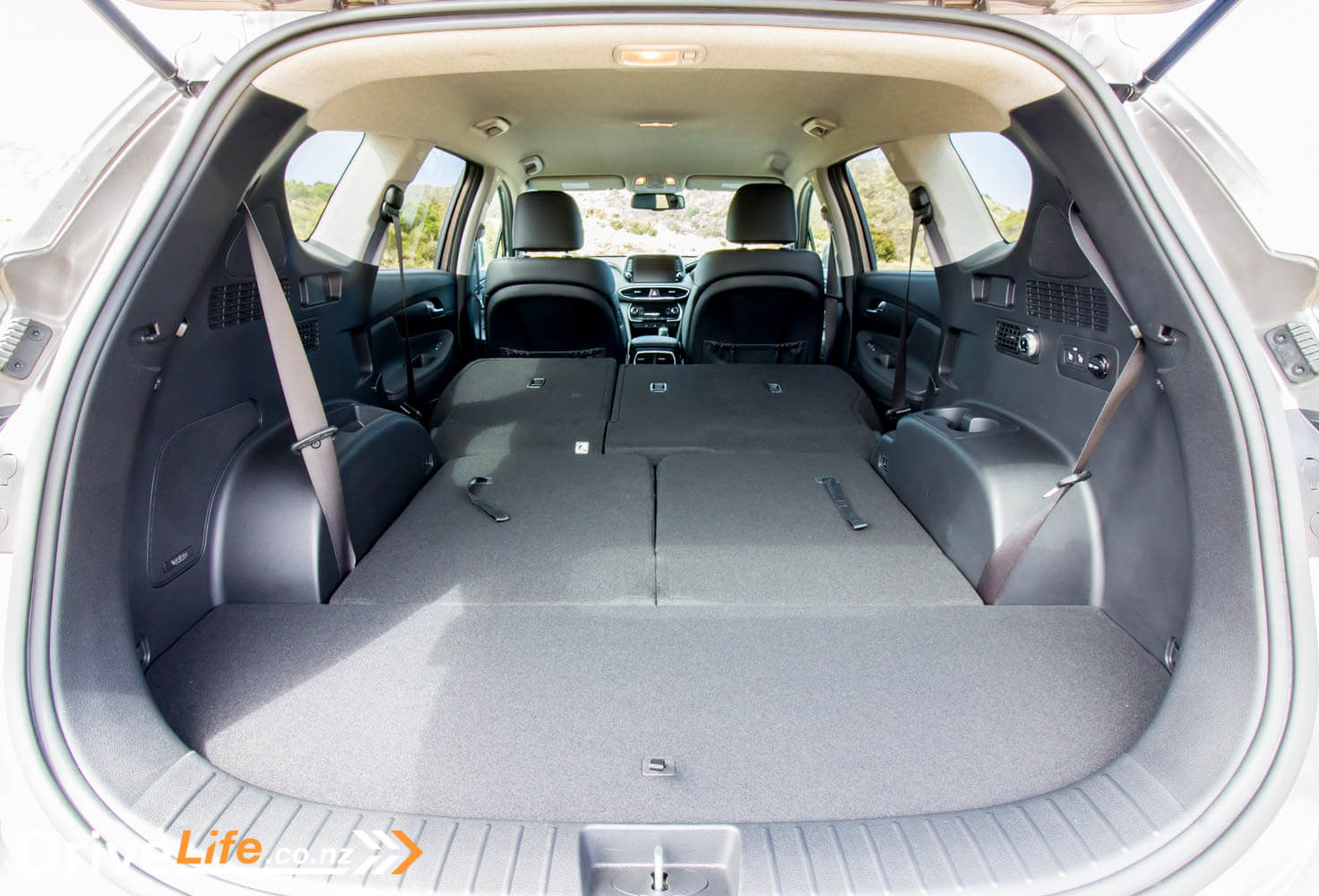
Speaking of which – that tacked-on central display, and more than one passenger remarked on it. It really looks like a total afterthought, and it always will. With other manufacturers now moving to more integrated displays, hopefully Hyundai will move the same way. Integrated looks so much better.
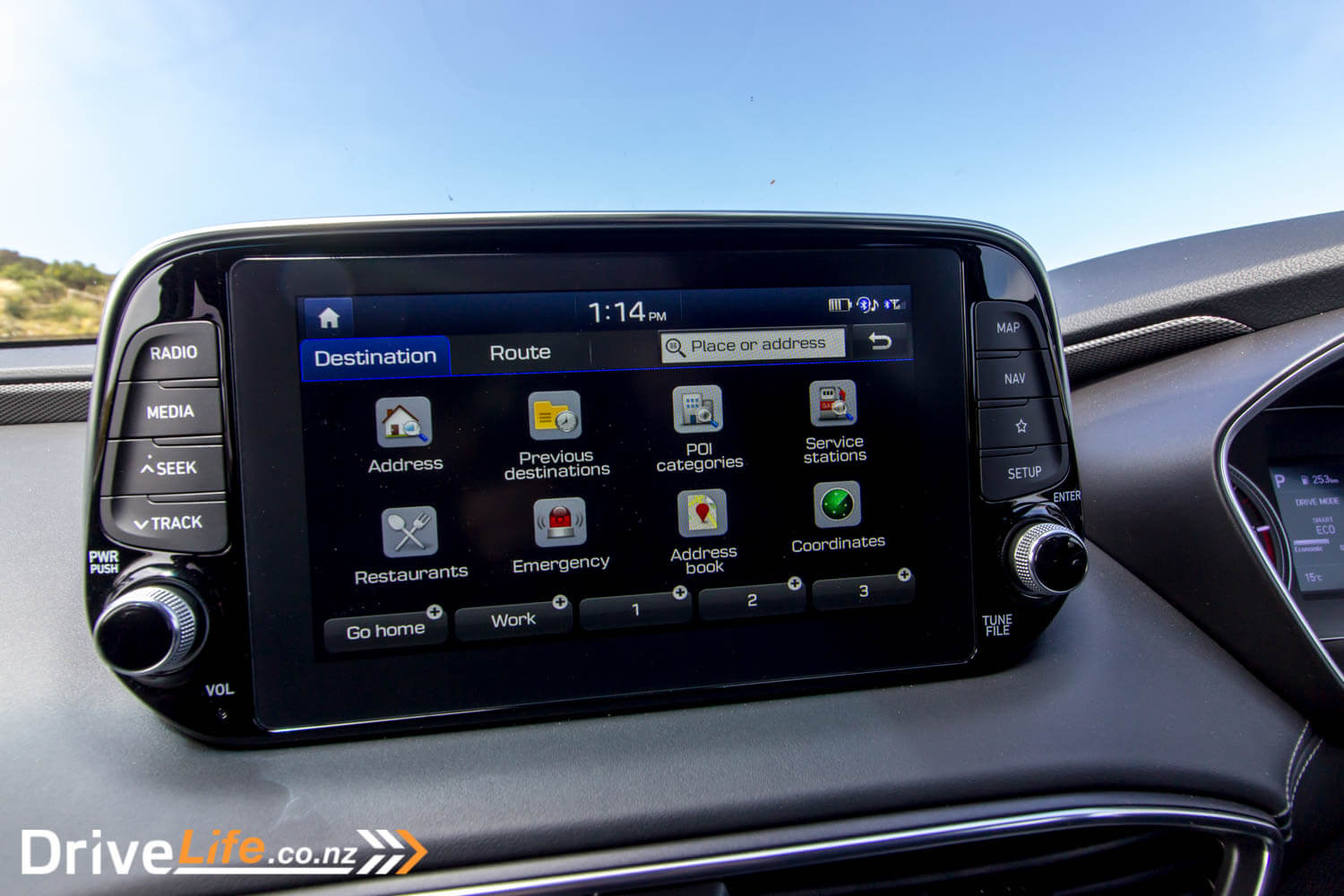
At times on our trip we had the audio cranked up a fair whack, and the quality is above average, with excellent separation. It is an upgraded option in the Elite model, over the standard model.
After a meeting, then the return trip, I didn’t feel too tired after a long day’s drive. No doubt the seats helped here, but overall the Santa Fe is a no-stress car, and does everything with little fuss. I can sure see why Hyundai Santa Fe owners are happy with their cars.
After a week’s driving and over 1,000km, I averaged 7.8L/100km of diesel. Not bad at all for such a heavy SUV, and Hyundai claims 7.5 on the combined rating.
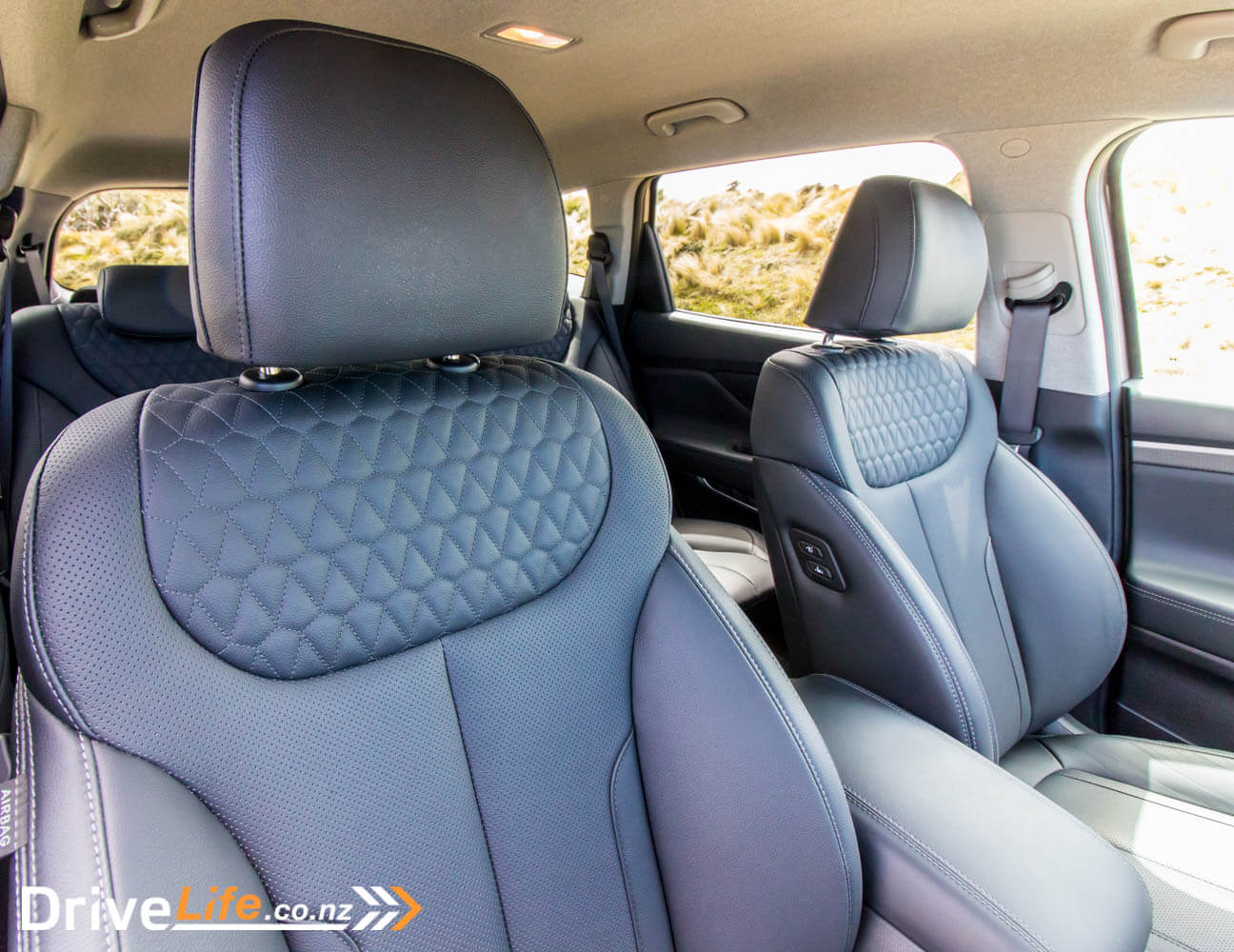
What’s The Competition For The 2019 Hyundai Santa Fe Elite 2.2 diesel?
There’s only one model of Everest, and its Ford top-spec Titanium, but I’ve included it for comparison.
| Brand/Model | Engine | Power/ Torque kW/Nm | Seats | Cargo capacity, litres | Towing capacity, unbraked/braked | Fuel L/100km | Price |
| Ford Everest Titanium | 2.0-litre twin-turbo diesel | 157/500 | 7 | 1050 | 750/3,100 | 7.0 | $79,990 |
| Hyundai Santa Fe Elite diesel | 2.2-litre turbo diesel | 147/440 | 7 | 547 | 750/2,000 | 7.5 | $76,990 |
| Kia Sorento GT Line | 2.2-litre turbo diesel | 147/441 | 7 | 605 | 750/2,000 | 6.5 | $66,990 |
| Isuzu MU-X | 3.0-litre turbo diesel | 130/430 | 7 | N/A | 750/3,000 | 7.9 | $66,690 |
| Mazda CX-8 | 2.2-litre turbo diesel | 140/450 | 7 | 742 | 750/2,000 | 6.0 | $64,195 |
| Skoda Kodiaq TDI Style | 2.0-litre turbo diesel | 140/400 | 7 | 630 | NA/2,000 | 5.7 | $63,490 |
| Seat Tarraco Xcellence 4Drive | 2.0-litre turbo petrol | 140/320 | 7 | 700 | 750/2,250 | 7.3 | $59,990 |
| Holden Trailblazer LT | 2.8-litre turbo diesel | 149/500 | 7 | 878 | 750/3,000 | 8.6 | $58,990 |
| Toyota Fortuner GXL | 2.8-litre turbo diesel | 130/450 | 7 | N/A | 750/2,800 | 8.6 | $54,990 |
| Mitsubishi Outlander VLS | 2.3-litre turbo diesel | 122/366 | 7 | 1048 | 750/2,000 | 6.1 | $49,990 |
| Ssangyong Rexton G4 TeamMate | 2.2-litre diesel | 133/420 | 7 | NA | 750/3,500 | 8.3 | $44,490 |
What’s The Pros and Cons For The 2019 Hyundai Santa Fe Elite 2.2 diesel?
| Pros | Cons |
| Quality interior materials, and textures Engine smoothness, quietness, performance Build quality Rear legroom Steering wheel controls Chassis brilliance Driving dynamics | Aggressive Lane Keep Assist Price |
The Verdict On The 2019 Hyundai Santa Fe Elite 2.2 diesel
This is an excellent SUV. I can’t imagine any Santa Fe buyer being unhappy with their purchase. It may seem like I got a bit picky with some things, but here’s the thing: they aren’t deal-breakers, they are relatively little things. As a driver’s car, it’s excellent. It’s also practical, quiet, smooth, spacious, well equipped, and refined. And for me, that’s the one-word description of the 2019 Santa Fe: refined.
There is an elephant in the room I’ve mostly avoided; the cost of the Santa Fe. It’s right up there in the range, especially with the Limited model touching $83,000. That’s a whack of cash for a Korean SUV. Will this affect sales? No doubt, but I stand by my claim that it’d be hard to find an unhappy Santa Fe owner.
So, the Big Question: can it take out the 2019 Car Of The Year award? Only time will tell. I’m not going to give any spoilers on what car my vote will go to, but the Santa Fe totally deserves to be in the top ten list.

2019 Hyundai Santa Fe Elite 2.2d – Specifications
4.5 Chevrons
| Vehicle Type | 5 door, large all-wheel drive SUV |
| Starting Price | $76,990 |
| Price as Tested | $76,990 |
| Engine | 2.2-litre, 4-cylinder common-rail diesel turbo |
| Transmission | 8-speed automatic |
| Power, Torque kW/Nm | 147/440 |
| Spare Wheel | Space saver |
| Kerb Weight, Kg | 1,870 |
| Length x Width x Height, mm | 4770x1890x1705 |
| Cargo Capacity, litres | 547 (third row down) 1,625 (second and third row down) |
| Fuel Economy, L/100km | Advertised Spec – combined – 7.5 Real World Test – combined – 7.8 Low Usage: 0-6 / Medium Usage 6-12 / High Usage 12+ |
| Fuel tank capacity, litres | 70 |
| Towing Capacity Kg, unbraked/braked | 750/2,000 |
| Turning circle, metres | 11.4 Small: 6-10m / Medium 10-12m / Large 12m+ |
| Warranty | 3 years/100,000km mechanical 3 years/100,000km roadside assist 10 years/200,00km body warranty |
| ANCAP Safety Ratings | 5 Star |
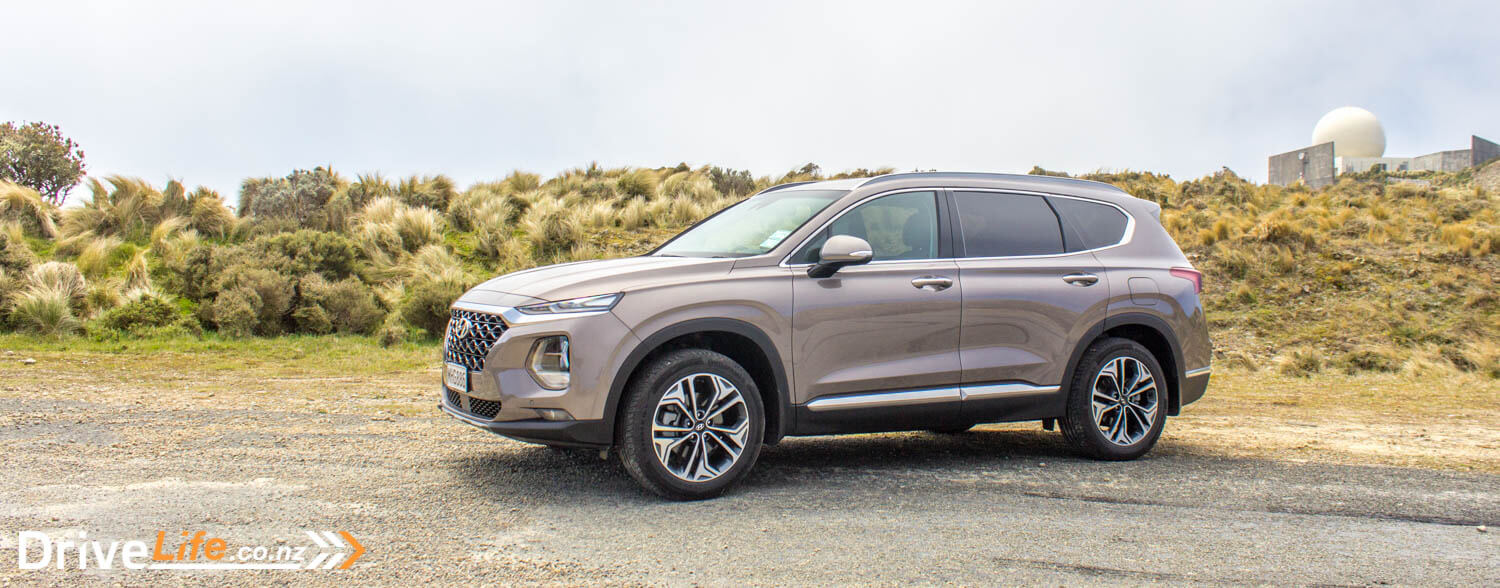


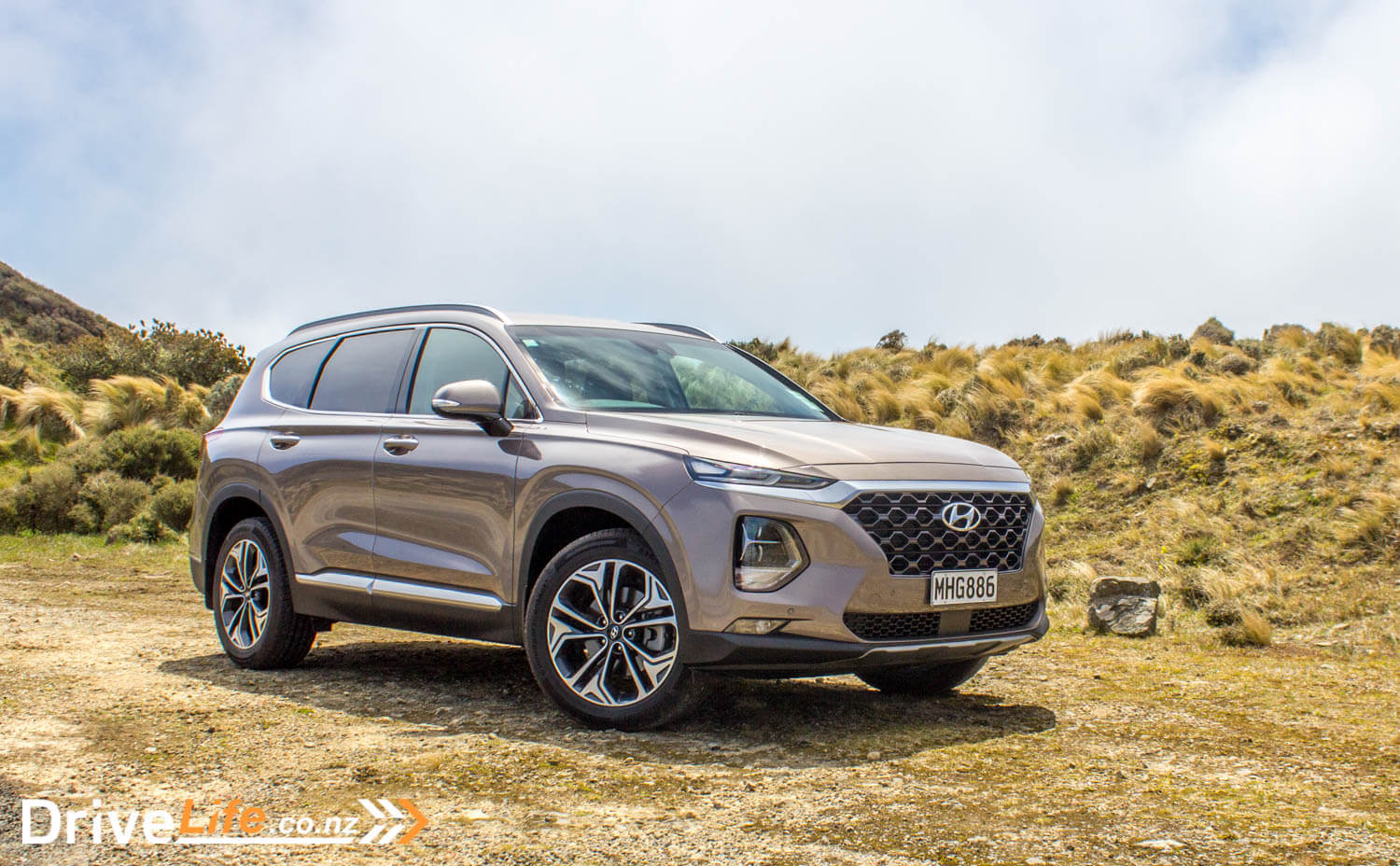











































Pricing? Look at the same car in Oz and see what they pay. (A$58) You’d be mad to pick the Santa Fe in NZ.
I’m really impressed with the 2019 Hyundai Santa Fe Elite 2.2 diesel. It’s a great car and I would definitely recommend it to anyone.